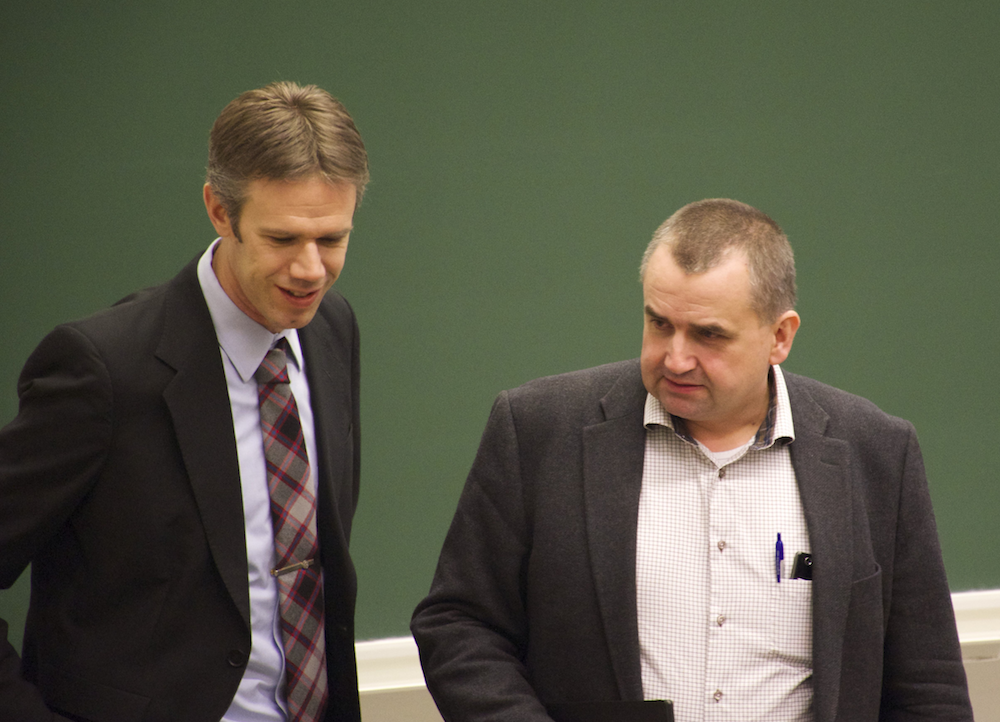News archive, 2014
Världspremiär för 5G-teknik i Lund
Published: 2014-12-30
|
Ett hett alternativ till nästa generations mobilteknik har nyligen testats för första gången i skarpt läge vid Lunds Tekniska Högskola. Det handlar om Massiv Mimo (multiple input multiple output) som förenklat går ut på att förse varje basstation med hundratals antenner istället för att som idag bara ett fåtal.
Digitaliseringen frestar på näten. Och värre lär det bli: Enligt Ericsson mobility report 2014 kommer den mobila datatrafiken i världen att öka från dagens tre exabytes per månad till 20 exabytes per månad år 2020. Mimo-tekniken är en metod att minska trängseln bland radiovågorna. – Våra resultat visar både att tekniken fungerar och att den mångdubbling av kapaciteten som utlovats i teorin kan uppfyllas. Det blir sammantaget en extremt energieffektiv kommunikation, berättar Fredrik Tufvesson. |
Fredrik Tufvesson och Ove Edfors |
|
Han och kollegan Ove Edfors presenterade rönen offentligt nyligen på den stora forskningskonferensen IEEE Global Communications Conference i Austin, USA.
Hela idén är att göra telefonerna enklare och låta basstationerna ta en större del av jobbet genom att de utrustas med betydligt fler antenner än idag.
– I framtiden kanske vi även kommer att se ett par hundra antenner. Tanken är att de ska vara så små och billiga att de kan bytas ut som en glödlampa. Går en sönder märks det inte så mycket och det är bara att skruva i en ny, säger han.
För att introducera Massiv Mimo i nätverken krävs avancerade algoritmer som styr signalen från basstationernas antenner till de platser där mobilerna för tillfället befinner sig. Detta blir möjligt eftersom 5G och kommande WIFI-nät kommer att vara annorlunda byggda än dagens 3G- eller 4G-nät.
– Dessutom vet vi mycket mer om hur radiovågor beter sig idag jämfört med för några år sedan. Det innebär att vi kan packa frekvensutrymmet med många fler dataströmmar utan att de stör varandra, säger han.
Om fem till tio år gissar Fredrik Tufvesson att tekniken kan finnas på marknaden, beroende på hur standardiseringsprocesserna fortskrider och hur snabbt man kan få fram billig och effektiv elektronik.
För mer information, kontakta Fredrik Tufvesson, professor radiosystem 046-222 46 29,fredrik.tufvesson@eit.lth.se (mellan 29 dec – 5 jan tillgänglig på mail) eller professor Ove Edfors 046-222 90 26 ove.edfors@eit.lth.se. För högupplösta, fria bilder på forskarna, se Lunds universitets bildbank, https://bildweb.srv.lu.se/ skriv namnet i sökfältet.
FAKTA:
MIMO, Multiple Input Multiple Output, innebär att både sändare (t ex basstation) och mottagare (t ex mobil) har mer än en antenn vardera. Tekniken kan implementeras i det kommande 5G-nätet och idag finns en grundversion i LTE, det vill säga i dagens 4G-mobiler med två till fyra antenner på basstation och terminaler. Tillägget massiv syftar på att basstationerna har många antenner och inte bara ett fåtal.
Forskning på den nya massiva MIMO-tekniken bedrivs främst vid Bell Laboratories, Rice University i USA, LTH och Linköpings universitet. Utöver testsystemet i Lund finns det en något enklare variant vid Rice University.
Idégivare: För några år sedan applicerade man MIMO-idén genom att själva telefonen fick fler MIMO-antenner. År 2010 föreslog en amerikansk forskare vid Bell Labs, Tom Marzetta, att istället utrusta basstationerna med väldigt många antenner – därav tillägget ”massiv”.
Basstationer kan liknas vid en kommunikationscentral. Den vet alltid var du är och slussar vidare dina samtal. Mobiltelefonen letar hela tiden efter den basstation som för tillfället är bäst att använda och meddelar då basstationen om sin närvaro så att nya samtal eller datauppkopplingar kan ske via denna.
Samarbetspartners: Linköpings universitet, Alcatel-Lucent/Bell Labs, National Instruments och Sony Mobile.
|
Carl Gustafson, fresh EIT-doctor.
Published: 2014-12-19
|
Attenuated waves An artificial water-filled plastic man ( a phantom ) without arms and legs is one of the Carl Gustafson uses in his research in order to "destroy" the propagation of the waves with wavelengths around millimeters. Many hope these waves will satisfy a large part of the future wireless bandwidth demands. The phantom simulates a human who stands in the way and suppresses the amplitude of the waves, an attenuation which is considerably larger for so-called mm - waves than for the "regular" wifi signals with wavelengths around 10 cm.
|
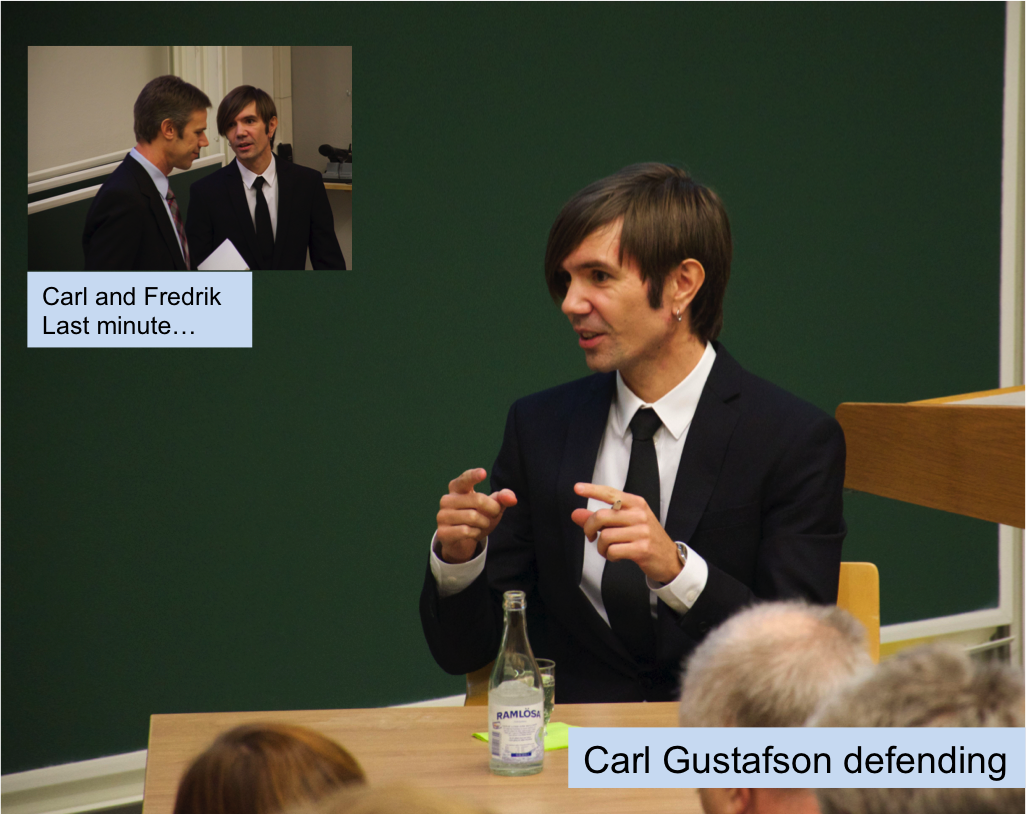 |
|
New acronyms coming up Much like we are accustomed to using the 2.4 GHz and 5.8 GHz for today's WiFi connections we will in the future use 60 GHz jargon. Scientists like Carl , technology developers and the world's standard bodies ( FCC, ITU and others) are working hard to refine this new frequency raw material for future bandwidth needs. These bands are license-free with the poetic name IEEE 802.11 ad . All connected! The increasing wireless traffic demands more and more on bandwidth and available spectrum . 50 billion or 500 billion connected gadgets is not the key issue. What matters is that it will be crowded in the ether. For high-speed communication at a distance shorter than 10 meters there is spare capacity around the globe around 60 GHz. In Europe e.g. there is a band between 57-66 GHz where theoretically bit rates of 7 Gbps can be squeezed in. That’s pretty fast, at least compared to the typical maximum of 600 Mbps in today's 2.4 / 5GHz wifi systems. Carl paves the way for new channels How the 60 GHz-channel between the transmitter and receiver "looks" needs to be further investigated and this is where Carl's research comes in. A wave that is around 12 cm long ( 2.4 GHz ) behaves differently than those with lengths of around 5 mm (60 GHz). Multipath propagation , shadowing , attenuation and other malicious natural phenomena must be dealt with and before you can do that, you have to identify the problems carefully. Carl's research helps us to better understand how the mm-wave propagation channels behave so that future solutions for these virgin frequency band can be optimized. Carl has modeled, characterized and evaluated the radio stations. Just as it says in the title of the thesis.
Arrived via a master thesis Fredrik Tufvesson, examiner when Carl did his master thesis on antenna design for breast scanning, lured him over to EIT and into the current research. Fredrik, with his solid scientific background in wireless communications and radio channels, have also been his supervisor during the mm-wave research. So far, the knowledge chase has been focusing around wave propagation indoors but Carls coming post-doc research within EIT will most likely bring him and his waves also outdoors. -Maybe even cars will talk to each other via mm-waves in the future, he says. Home is Malmö and Värmland Where does a Lund-researcher live? Is it Malmö? Is it Lund? -Lund has been very nice so far but I decided to exchange the small-city life for something bigger. And metropolis Malmö was well at hand, says Carl. -Thus, a move to the third city took place and accommodation in the area around Folkets Park and Möllan became a nice stay. ... says Carl and takes off for Christmas celebrations at home in Värmland. EIT congratulates and wishes Merry Christmas! And we look forward to lovely new, yummy bandwidth during 2015th.
|
IMEC-professor honorary doctor at LTH
Published: 2014-12-16
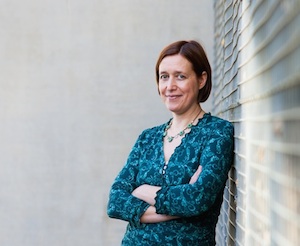 Liesbet van der Perre new honorary doctor |
Forskningsteman på EITs hemsida
Published: 2014-12-10
 Forskningsteman på hemsidan |
Lars Hedenstjerna avtackad
Published: 2014-12-01
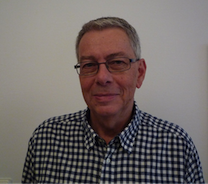 Lars Hedenstjerna avtackad som pensionär |
Gerhard Kristensson avtackad
Published: 2014-12-01
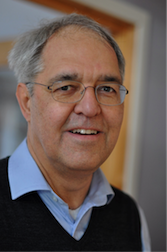 Gerhard Kristensson avtackad som pensionär |
Three papers on IEEE top 100
Published: 2014-11-28
As many as three EIT-papers were among the top 100 most downloaded during October 2014.
The papers positioned 5th, 54th and 63rd. The highest placed paper "Massive MIMO for next generation wireless systems" is authored by Erik Larsson, Ove Edfors, Fredrik Tufvesson (EIT) and Thomas L Marzetta (Bell Labs).
You'll find the whole list here: http://ieeexplore.ieee.org/xpl/browsePopular.jsp?reload=true
Text: Johan Cedervall
Exjobb fick hedersomnämnande
Published: 2014-11-18
Vanja Tufvesson och Nicklas Erman har tilldelats ett hedersomnämnande för deras examensarbete "Navigating Information Overload Caused by Automated Testing" i ämnena Elektroteknik- och informationsteknik och Datavetenskap. Vanja och Nicklas erhåller ett diplom för detta under examenshögtiden den 28/11. Handledare har varit Anders Ardö, EIT och Markus Borg, CS. Examinator var prefekt Per Runesson från CS. EIT gratulerar! Exjobbet använder moderna metoder för klusteranalys, från forsknngsområdet informationssökning,för att klustra information från automatiska mjukvarutester. Detta gör det möjligt att effektivisera analysen av utfallet från dessa tester högst väsentligt. Metoderna har implementerats i ett program som används dagligen vid företaget och ett manuskript till en vetenskaplig artikel skickas i dagarna in till IEEE International conference on Software Testing, Verification and Validation. Examensarbetet är ett föredöme i gränsöverskridande och integrerande arbete: två civilingenjörsprogram, två institutioner, två forskningsområden och naturligtvis industri-akademi-samverkan. Studenterna - Vanja från Teknisk matematik och Nicklas från Datateknik - har med handledare och examinatorer från både EIT och Datavetenskap, åstadkommit en tydlig förbättring på företaget Qlik, som samtidigt ligger i tillämpningsforskningens framkant inom software engineering.
"We need more female role models"
Published: 2014-11-12
Maria Kihl is promoted to professor of Internet systems and is the first female professor at EIT, number two overall in Electrical Engineering and Computer Science at LTH.
– It feels great, it was a long awaited decision! What feels less enjoyable is the fact that it's just me and Görel Hedin who have became professor here over the past 50 years, says Maria Kihl.
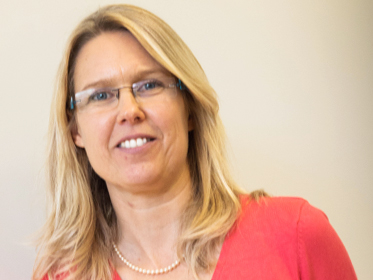 Professor Kihl |
Wants to see more role models
On average, only about one-fourth, or 23%, of the professors in Sweden are women (SCB, Statistics Sweden, 2013). Amongst the technical faculties, they're only about one out of nine. Maria thinks, like many others, that this is a problem that needs to get solved.
– First, we need to have a broader recruiting base than the 10-12% of students with us who are women. Then, you have to actively work to get the well-performing girls to stay here. We can also recruit women from outside, says Maria who seeks more role models to get the ball in the proper rolling.
– We need more female role models. And not only women but for all minorities – we need to create an environment that clearly shows that it is possible to succeed in this field even if you are not part of the majority.
No matter of course
For Maria, it was never a matter of course to build an academic coureer.
– Definitely not! I never felt that technology was something for me ... But I liked math and I liked programming, so I ended up at LTH anyways, studying computer science. And it was fun! After that, my plan was to get a job in the industry, Ulf Körner persuaded me to study for a PhD in Telecommunications and I'd finished it he persuaded me again, so I stayed here and I haven't regretted it since! I really enjoy it, certifies Maria.
Likes to cooperate
She enjoys the mix of research and teaching, the free way of work, traveling and the fact that no two days are exactly the same. Her research is largely about optimizing traffic on the Internet, creating preconditions for both faster and better services – eg video streaming and cloud services – but without increasing cost too much or creating a higher load on the systems. Maria's involved in various projects in which she collaborates with various individuals and organizations. In one of the projects she works a lot with Automatic Control at LTH and Computer Science at Umeå University, in another one the lead partner's Acreo Swedish ICT AB in Kista.
– For me, this kind of cross-border collaborations are both natural and important – I like to collaborate. I also like to travel, but well, lately I've mostly been to Stockholm and that's not so cool I suppose, she says with a laugh – being a native of Skåne (Scania).
Swedish, English, math – and programming
Maria likes to cooperate – and she loves programming.
– I feel that programming, in many places, is more or less expected to be learned at home. And that it should be taught in a wider extent at school. I think programming's a very important tool that you can start learning early, and I would say it's the most important thing to learn along with Swedish, English and math. It's applicable in so many areas, says Maria Kihl and adds in conclusion:
– Above all, it's great fun to program!
Text & photo: Johan Cedervall
One hundred percent Sweden for Antenna Researcher Marius.
Published: 2014-11-04
Swedish, Sweden, Stockholm and Ericsson. Marius leaves Lund and prepares to work with telecommunication systems in the capital.
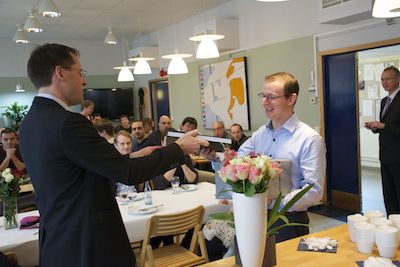 Marius Cismasu and supervisor Mats Gustafsson |
-Would it be OK conducting the interview in Swedish?, I ask Marius Cismau, EIT's latest doctorate. He tells me it should be fine. And it's true, Marius has, after having lived in Sweden for several years, got a pretty good hang of our, not too easy, language. We talk on the phone as him and his family, consisting of his wife and their 2-year old daughter, have already moved to Stockholm. More precisely Jakobsberg, where they've found a place to stay. Marius will now join the crowd of commuters in Stockholm as he makes his way to Ericsson in Kista every morning. Train, bus, scooter or maybe cycling? -We'll see, Marius says. -One thing at a time. The new doctorate will help Ericsson with system design and hardware development for their base stations. A job that will suit Marius perfectly, as system design is something he's been wanting to do for several years.
Glad to have done research on electromagnetism and happy to have worked at LTH.
I ask about LTH and EIT, how has he found it? Good or bad? He's quick to reply: -Good, of course! -A good time, good co-workers and good equipment. -And very educational. -And good supervisors of course! -I chose to do a doctorate because of my fascination with nature and its scientific description, says Marius. -I've always, as a hobby, researched a bit with the means available to me. Thanks to his enthusiastic supervisors Mats Gustafsson and Gerhard Kristensson, this lead to “real” research and a nice scientific journey. Marius has found the subject especially fascinating due to the almost magical qualities of electromagnetic waves. They're like mechanic waves in a way, but not quite.
Helping antenna engineers to install antennas everywhere
Marius' research has more specifically been about antennas. All kinds of things in everyday life have antennas today. Not just mobile phones, computers and tablets, but also cameras, printers, watches etc need to be able to connect wirelessly to the internet to make use of its various tools and services. Therefore, developing electronics today often involves antenna design, which is an advanced and resource-demanding part of the process. Not least because appearance, size and design vary greatly between products. How good can an antenna be? How do you optimise antennas? Where in the product is the best place for the antenna? These are some of the questions needing an answer and parts of the results of Marius' research describe methods that can be used to improve the design process of antennas. His thesis also shows a way of cutting the amount of time needed to design antennas and supplies methods and tools for antenna engineers.
From physics to electronics and from electronics to telecommunication
Dr Cismau comes from a small town in Romania named Calarasi and located 120 km southwest from Bukarest, towards the Black Sea and he has been interested in the natural sciences ever since his first Physics lessons in school. His interest in science was further strengthened as a teenager by reading books containing exciting practical experiments. Ever since then he has wanted to be a scientist. A dream that has now come true.
After completing his masters in Bukarest he turned his sights from Physics to Electronics and especially wireless electronics. Marius' reasoning was that telecommunications provided more opportunities for work and career progression. And indeed, it resulted in a job at Ericsson! Before then, he has been employed as an designer and a test engineer within various fields of electronics, for example digital technology, embedded, microwave links etc.
In 2009, the economic recession hit Romania. -I was forced to return to test engineer jobs and therefore promoted myself by applying for doctorate studies and chose the reputable LTH as my place of study.
As mentioned, Marius has now moved to Stockholm and has secured a job at Ericsson. What happens next remains to be seen. -It's exciting not to know everything that's going to happen, says Marius Cismau. Everyone here at EIT congratulate him on his graduation, wish him good luck in the future and we hangup for now.
Text/Photo: Anders Borgström
Lars Hedenstjerna i pension
Published: 2014-10-30
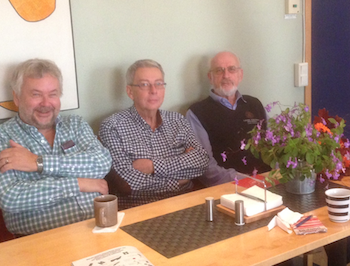 Lars Hedenstjerna med gamla kollegor |
Low-power radioplatforms in Rezas research
Published: 2014-10-28
Reza Meraji's research optimises low power consumption over data speed and range for applications in Body Area Networks with miniaturised electronics and remote sensors.
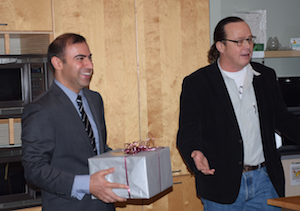 Reza Meraji and supervisor Viktor Öwall |
Reza Meraji was born and raised in Teheran, Iran, and when I ask him what it's like to live in Sweden he replies that the weather takes a bit of getting used to and he always misses home a little bit. But the job opportunities are without a doubt more plentiful than in Iran, at least within his advanced and highly technological discipline. Reza now has a Doctorate and his thesis is entitled “Low Power Decoding Circuits for Ultra Portable Devices”. The work is within a sector that is becoming more and more important as electronics are becoming ever more miniaturized and low power profiled. After a Bachelor's Degree and a couple of years' work in his home country, Reza was looking for opportunities to continue his university studies abroad, which lead to an international program of system-on-chip at LTH. After graduating in the Masters-programme he worked for Sony Ericsson, which he found interesting and a good experience but not challenging enough for an engineer with a further thirst for knowledge. A doctorate at EIT proved the perfect solution. Reza joined as an important part of a bigger project, where close cooperation with other researchers was crucial to success. This way of working was a perfect fit. The aim of the research group was to develop a fully functioning and extremely low power radio platform which would be applicable within various areas.
Low currents, short ranges and low bit-rate
So what is Dr Meraji's research about? It is about very low power technology for wireless application and thus also compromising with data speed and range. For, say, a pair of hearing aids (one in each ear) communicating with each other or a medical device within the body transmitting data to measuring devices outside the body, speed of data and long range are less important parameters. An additional use could be a moisture indicator cast in concrete where a change of batteries would be impossible. The most important thing is that they are very small and use very little power. During his time at EIT, Reza has focused on optimising fault detection and correction with the help of his circuits and has therefore been able to present very low power solutions for, among other things, so called BANs (Body Area Networks) where low data rates and short range can go far.
A lot of fun on the road
The research has entailed combinations of theory together with analogue and digital hardware implementations which has lead to lots of varied and diverse work at the institution. Lots of fun has been had at EIT as well, especially with exciting trips to conferences and the satisfaction of meeting strict deadlines after days and nights of hard work in the lab. In addition to exercising his brain at work, Reza also likes to keep fit by running and going to the gym, and enjoys reading books, hanging out with friends and spending time in nature. After-work socialising and barbecuing with work colleagues are some of the many happy memories he will take with him from his time in Lund. And now what? Well, a challenging industry job with lots of opportunities for development is never a bad option, but you never know what's going to happen. Decisions can be made and decisions can be changed. For now, Reza is keeping his options open. Text/Photo: Anders Borgström
Framtidens forskare och ingenjörer konfererade
Published: 2014-10-24
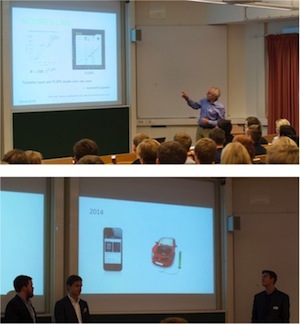
Text/Photo: Anders Borgström
EIT-forskning syntes på MHC-Invigning
Published: 2014-10-24
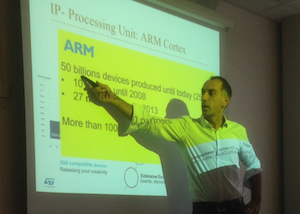
Text/Photo: Anders Borgström
Smaller and faster building blocks
Published: 2014-10-14
Sofia Johansson's research is about the very basic building blocks of electronics. That's right, transistors. For her, ending up in this field was the result of both coincidence and interests.
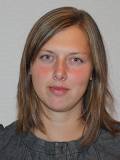 Sofia Johansson |
Fast and tiny
Electrons are more flexible in Indium Arsenide (InAs)-based transistors than they are in Silicon-based ones. Faster transistors and low-power electronics are on the horizon if Sofia's results are implemented in the integrated circuits of the future. Indium Arsenide instead of Silicon, new connectivity approaches and vertical 40nm nano-threads are just some of the jargon she uses when explaining her research. By the way, a single strand of hair is more than a thousand times thicker than the nano-threads in Sofia's lab, which implies the whole thing is really quite fiddly. The connectivity around the nanowires opens up the possibility of creating smaller transistors which in turn will be extremely fast, several thousand times faster than they were around the time when Sofia first started her research. Hence, the road to high speed electronics is a given.
- My main task has been to optimise the production of transistors and measure the high frequency qualities of transistors, Sofia tells us.
Interest plus coincidence turned into research
Why does someone want to do a PhD and what's so interesting about nanotechnology based electronics? As often happens, it all comes down to various coincidences and in Sofia's case the dream of conducting research was not there from the start. Instead, her interest in electronic components and nano technology was simply materialised in a doctorate. In other words, one coincidence and one good opportunity.
Home is Laholm, Lund, Fysikum and EIT
Laholm is her home town, and in searching for the nearest (and best) university, Lund was the obvious choice. Sofia has a solid interest in technology, materials and physics and volunteered to be one of the first students on the newly founded nanotechnology program. In addition, Sofia has changed research department during her time in Lund as the nano technology department has moved from the Physics department to EIT. After having been employed by Fysikum for three years, all her work now takes place at EIT.
Wants to do more research
The interest in doing research is still there and in the future, Sofia's aim is to create more knowledge benefiting the wider society. She is not yet sure of what the future research will entail but the general direction is clear.
- I would really like to continue researching on technology in some form, either in academia or in the industry. At the moment, I'm not quite sure on what, but there are lots of really exciting fields of research, says Sofia as she steps into the upper ranks of academia, with the title of PhD now on her business card.
Text/Photo: Anders Borgström
MIMO wheels-up
Published: 2014-10-06
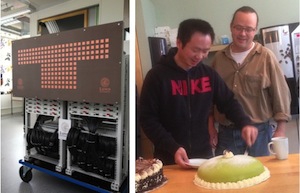
Text/Photo: Anders Borgström
His PhD thesis was awarded
Published: 2014-10-03
Federico Pepe’s PhD thesis was recently designated as the best in information technology by Politecnico di Milano. Since about a month, he’s in Lund for one and a half years of postdoctoral employment. The assignment consists of designing frequency synthesizers.
– And VCO:s – so that Viktor can still make jokes to Piero, he says with a smile.
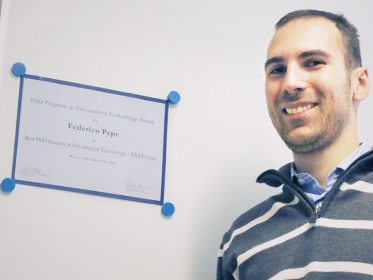 |
Referred by his opponent
Federico grew up in Campania, southern Italy, but has been spending the last ten years at the university Politecnico di Milano – the oldest university in the county, founded in 1863 – in the more northerly parts of Italy.
– I had a chance to stay in Milan but wanted to do something else. Among other things, I tried to get hired by Qualcomm in San Diego. Piero (Pietro Andreani) was my reviewer and it turned out he had a spot for me here, Federico tells – and seems to enjoy it.
Goal-oriented
He’s in the area of analog IC-design and involved with the DARE-project.
– My goals are to complete the task I’ve been assigned which is to design frequency synthezisers. And VCO:s – so that Viktor can still make jokes to Piero, he says with a smile and explains:
– Piero is a top expert in the area. He gets a lot published and, at least for the conversant, it may look very simple with pictures of very simple circuits. So Viktor uses to twit Piero for this. Though, there are a lot of very advanced contents to those circuits – and Viktor knows about this, of course – but he still doesn’t miss a chance to joke with Piero about it anyway!
Had forgotten about the prize
The awarded thesis is a true rarity since it’s only been printed in one (!) copy and that copy’s in the library of the university of Milan. It’s also award-winning, Federico received both money and a diploma for his efforts.
– Everybody starting a PhD there knows about this prize. I had somehow forgotten about it because I finished my PhD and left Milan. So when the secretary called and told me about this I couldn’t really get it so I had to call back to duble-check, he says and smiles.
Doesn’t enjoy the jam
With some surprise, we note that the laminated diploma’s lacking the university seal, before it’s time for photos and general loose talk about life in Lund. Federico plays tennis and is also interested in climbing.
– The area around Lake Maggiore is one of the most beautiful places I’ve been, he says.
– I don’t have much spare time but when I do I usually meet up with Italian friends and sort of circulate the town.
I get no insider tips on good Italian restaurants in Lund.
– I’m not an expert of Italian restaurants in Italy either. I don’t like the jam you put on meat here though, he says, and we can’t really determine if it’s the lingonberry jam that’s caught his disliking attention. But it probably is.
Text & photo: Johan Cedervall
Couldn't resist electronics
Published: 2014-10-01
Dejan Radjen was supposed to become a physicist, but after having discovered electronics he couldn’t resist it. Now he’s got a doctoral degree in the subject, specialized in construction of A/D-converters (analog-to-digital converters).
– The very first thing I was fascinated by in electronics was wireless transmission of information. I found it very interesting how waves can be caught from the air and recieve the information those waves transported, he says.
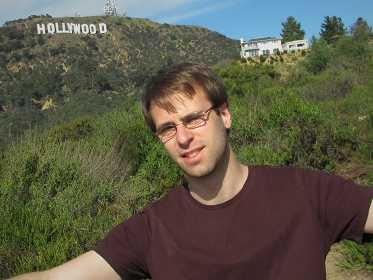 Likes to travel |
Supposed to become a physicist
Dejan Radjen’s born in Serbia but a Swede since long. He’s always had a great interest in science.
– What’s interesting about science are those moments when you discover how things works. You get a rush from it! I was supposed to become a physicist, but after discovering electronics and built some circuits at leisure, as a hobby, I couldn’t resist it because it’s practical and close to reality. LTH was a natural step towards a deeper understanding. And I lived nearby Lund already, Dejan tells.
Immediately got into wireless communication
If it was a little unexpected that Dejan would take interest in electronics, it was a little more expected what area within it that would grab his main focus.
– The very first thing that I was fascinatied by in electronics was wireless transmission of information. I found it very interesting how waves can be caught from the air and recieve the information those waves transported. After been given the chance to do my master’s thesis at Ericsson, I felt that I had a good foundation but at the same time I felt that some bits wer missing and I wanted to learn more! That’s why I decided to pursue a PhD, to learn more about A/D-conversion, which is a step in the reciever chain that’s used for wireless transfer.
Specialized in construction of A/D-converters
On September 18th, Dejan presented and defended his doctoral dissertation ”Continuous-Time Delta-Sigma Modulators for Ultra-Low-Power Radios”.
– Wireless communication is a frequent participant in our modern day. A big challenge in this area is the power consumption and lots of research is required to reduce the effect in a radio chip for wireless and low-power applications and still obtain a stable connection without interference, Dejan tells and develops:
– An essential part of a radio chip is the A/D-converter. It’ll always be needed because the world is naturally analog but all devices demand digital signals to acieve the functionality considered important these days. My research is about construction of A/D-converters for wireless low-power applications at short distances.
Wanting to learn more
Dr Radjen still has a hunger for more knowledge in his subject.
– I usually don’t plan things very far ahead, I take them as they come. But I’m definitely interested to further expand my understanding of electronics for wireless communication and also travel around to other places, he says, and highlights fruitful meetings – formal and informal – with colleagues from all around the world at LTH.
– I think that’s one of the most important factors at LTH.
OAM vs MIMO
Published: 2014-09-30
Text: Anders Borgström
Energized by dad’s legacy
Published: 2014-09-30
A nice campus and the significant world ranking made Meifang Zhu leave her job and move to Lund, to catch a mutual dream and pursue a PhD. “My father's desire and thirst for knowledge deeply influenced me”, she says.
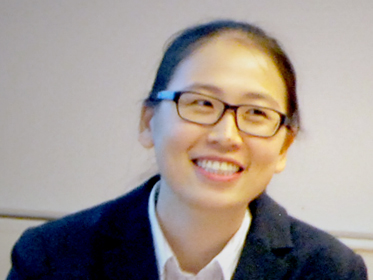 Meifang Zhu |
Ranking and nice campus
In 2007, Meifang Zhu made one of the most important decisions in her life. She quit her first job back home in China, to take further education abroad. She chose Sweden, Lund and LTH.
– Lund University came to my eyes because of the significant world ranking and the nice campus, especially the white house. Electronic engineering is my favorite topic, LTH became my first choice, Meifang explains.
Had to quit education aged 15
Important decisions aren’t always easy to make. Meifang got a great deal of strength to from the support from home, to chase the dream and to catch it. And the greatest supporter is her father, wishing Meifang would be able to do what he didn’t.
– My father's desire and thirst for knowledge deeply influenced me. He had to give up his education when he was 15 years old, so he has put all his effort into making sure that I received a good education. This legacy has always energized my pursuit of a Ph.D. degree.
Making the invisible visible
On September 12, 2014, she defended her doctoral dissertation “Geometry-based Radio Channel Characterization and Modeling: Parameterization, Implementation and Validation”.
– Wireless channels, which are present everywhere, and they are untouchable and invisible to the naked eye. In my subject, the untouchable and invisible channels can be modeled with certain real world parameters and represented by touchable mathematical models.
Positioning with accuracy down to centimeters
– The keyword of wireless technology is 'Wireless', but without a wire how can we get hold of other people? The answer is wireless channels. It is essential to understand the behavior of the wireless channels and capture their characteristics as much as possible. Therefore, channel models, which gives a close to realistic description of wireless channels, becomes significant important for wireless system development.
– The COST 2100 channel model is one well established wireless channel model that can be integrated with current and next generation wireless systems. In my thesis, efforts have been made on parameterization, implementation and validation for the COST 2100 channel model. To be able to have a thorough understanding of wireless channels, a measurement based-ray lunching tool has been implemented in this thesis to visualize the propagation path on top of the 3D map. In addition, we have investigated the possibility to using the radio channel for positioning with accuracy down to centimeters, where the standard cellular system bandwidth is used.
Ready to fly
The future’s looking good for Meifang, who’s urging to get out there to try her wings and fly amongst all those invisible wireless channels.
– I have been as a student for 22 years and have been learning telecommunication and wireless communications for more than 10 years. Now it’s time to put my skills gained during the past years into practice!
– The time at LTH and EIT has been a nice experience for me, to work with people from all over the world in the same group. Not only had I learned knowledge but also different cultures, Meifang Zhu closes cheerfully.
Best on Top 25!
Published: 2014-09-25
Mohammed Abdulaziz, together with co-authors Markus Törmänen and Henrik Sjöland, recently published the journal paper "A Compensation Technique for Two-Stage Differential OTAs". It received the highest number of downloads in August 2014. Every month top 25 papers are listed in the following link of the well-known TCASII journal. Congratulations to Mohammed and the team! http://ieeexplore.ieee.org/xpl/topAccessedArticles.jsp?punumber=8920 To document
Text: Anders Borgström
Triple in Nanoelectronics
Published: 2014-09-24
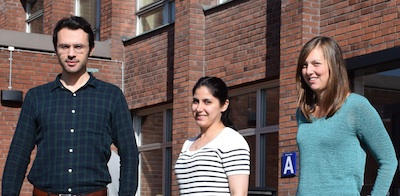
Dean election determined
Published: 2014-09-23
Department head of EIT, Viktor Öwall, had been voted dean of LTH from 2015 to 2017.
 Viktor Öwall. |
According to the election results, the following suggestions regarding the new dean, vice dean and faculty representatives, and representatives of other staff to Board of Directors of LTH and Nominating Committee's proposed business representatives in LTH board for the mandate period 2015-01-01 - 2017-12-31 to the Principal of the University of Lund:
Dean:
Viktor Öwall, prof, Elektro- och informationsteknik
Vice Dean:
Annika Mårtensson, prof, Bygg- och miljöteknologi
Teacher representatives, board of LTH:
Anne Landin, prof, Inst. för Byggvetenskaper
Maria Johansson, prof, Inst. för Arkitektur o byggd miljö
Stefan Kröll, prof, Fysiska institutionen
Marilyn Rayner, univ. lektor, Inst. för Livsmedelsteknik
Thomas Laurell, prof, Inst. för Biomedicinsk teknik
Aylin Ahadi, univ. lektor, Inst. för Maskinteknologi
Peter Rådström, prof, Kemiska institutionen (omval)
Representatives, other employees, board of LTH:
Marianne Olsson, Inst. för Immunteknologi
Johan Hugosson, LTHs kansli
The Nomination Committee's proposals to industry representatives in LTH Board for the term 2015-01-01 – 2017-12-31:
Charlotta Falvin, professional board, chairman
Sven Landelius, charirman ESS AB
Jerry Bengtsson, CEO AB Tetra Pak
Read more:
Everything about the election (LTH.se)
Lund Circuit Design Workshop 2014 delivers state-of-the-art and glimpses of the future!
Published: 2014-09-16
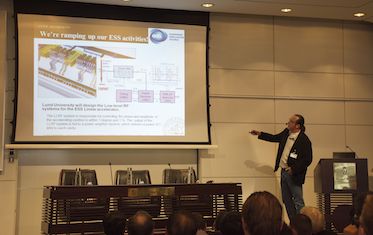
Brains in Circuit Design!
The "Lund Circuit Design Workshop" took place at Grand Hotel and LTH-EIT during thursday and friday last week. The workshop, hosted by the VINNOVA-financed project INDEC-SoS and the SSF-financed projects Distrant and DARE., gave an overview of the research activities within IC design at Lund University. Invited speakers from both industry and academia covered a number of highly interesting topics. Jan Rabaey, UC Berkeley, inspired on the potential of applying natures computational-, storage- and communication solutions in future circuit and system design. Ivo Bolsens, Xilinx, presented the latest around highly advanced FPGAs. These devices nowadays include building blocks like entire ARM-processors, DSPs, large memory areas, mixed-signal blocks and advanced IOs. Johan Svener from Sony Mobile addressed the future roadmap of advanced low-power wearables and emerging use-cases around that. Jonas Hansryd from Ericsson talked on how mm-wave technology will impact coming 5G-systems and Mustafa Özen shared the latest research within low-power wireless PAs. EITs inhouse researchers from PhDs to senior professors gave extensive presentations on Massive-MIMO, antennas, mixed-signal, baseband, filter, ultra low-power design, energy optimization, beamsteering and much more. Poster sessions, coffee-breaks and excellent food contributed to another perfect Circuit Design Workshop as acknowledged by visitors, speakers, Director Viktor Öwall and Chairman of the Board Sven Mattisson. Logistics were, as always, perfectly managed by Pia Bruhn.
Text/Photo: Anders Borgström
New book
Published: 2014-09-05
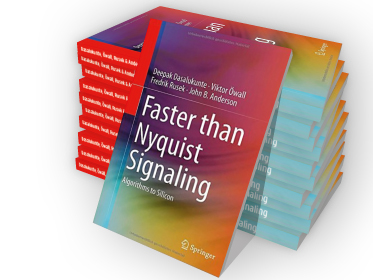
Springer recently published a book authored by EIT researchers: Faster than Nyquist Signaling: Algorithms to Silicon by Deepak Dasalukunte, Viktor Öwall, Fredrik Rusek and John B. Anderson.
The book is an adaptation of Deepak’s PhD thesis that was defended in 2011 and was financed by the SSF project The High Speed Wireless Center.
Anil Dey from EIT to Intel as "outstanding researcher"
Published: 2014-09-02
Almost a year ago, Anil Dey defended his PhD thesis "Low-Power Circuits and Nanowire Transistors". A month later, nano-engineer Anil was interviewed by the giga-company Intel, in the US. In January he received an offer of employment at this one of the world's leading electronics companies. Then the hard part began.
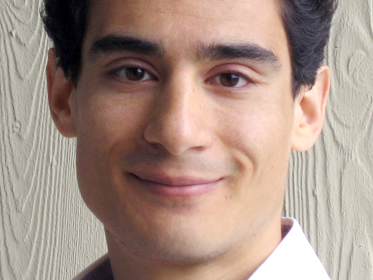 Anil Dey. |
Check the box if you have received the Nobel Prize
– It wasn't easy to get a visa!, Anil explains. He was one of a total of about 172 000 applicants with a Bachelor degree or higher, to split the total of 65 000 visas. Another 20,000 visas are awarded to those with master's degree or higher, in which group Anil was also included. But he scored nil in both lotteries. No visa.
– In the end, I managed to look into something called "outstanding researcher visa". It was somewhat deterrent to read the requirements for the visa – it was something like "Proof that the applicant has received a major internationally recognized award, as a Nobel Prize, or evidence of at least three of the following requirements." When a Nobel Prize was hard to muster on short notice, I was instead forced to comply with the alternative requirements. An example of the requirements demanded including letters of recommendation from at least six impartial and qualified assessors to vouch for my research was the host class standards and that I was a leading researcher in my field. After many trips did it in the end and now I have an approved visa - it is said that I should start at Intel in Hillsboro, Oregon, in two months, says Anil Dey.
The dream arose in high school
29-year-old Anils parents met in Lund. Dad Subhas is originally from India and was a teacher of mathematics and science, mother Estera originates from Poland and works as an associate professor at Applied Biochemistry at LTH. But despite his parents' occupational interests, Anil never felt compelled to become an engineer.
– Mom said I should be a doctor! But I didn't agree, Anil says with a smile.
Instead, it was a school visit by a physics professor who arose Anils dream. At the visit, the professor was explaining that there was a whole new world to explore - a world where electronics, physics, chemistry and biology converge to allow things previously considered impossible. It is not difficult to understand that the interest was awakened and Anil were part of the very first class to read Engineering Nanoscience at LTH.
Worried about the container journey
Today, about ten years later, he holds a doctorate in the field and is headed for an amazing adventure at Intel.
– I'm starting as a so-called ”device engineer” and will develop the technology for future generation processors, says Anil who is in the process of organizing the move to the US.
– Intel are taking very good care of their staff, they help to organize almost everything. "We'll send you a twenty foot container," they said one day, and I thought that it really is necessary, I don't have tha much stuff! You'll get a car in a container like that, if you want to!, Anil says with another casual smile but with some concern about how the self-crafted interior fittings shall be clear container journey across half the globe.
– But they send a mover company to go through everything, so let's hope that they make sure that everything will be well packaged too.
LTH highly regarded in the world
He 's looking forward to the new adventure, and he's looking up to his new colleagues at Intel. They seem to have impressed him, as he's impressed them.
– Research in Lund has a very high reputation in the world. Our research on the EIT is not infrequently used as a reference for world-leading researchers and companies present "state-of-the-art" components and concepts. One such occasion was the example of the "star-conference" in the field, the International Electron Device Meeting (IEDM), where the best people in the field gathers and the best wirk gets presented. At a conference in the USA a few years back, I received a number of interesting questions from an Intel-guy, actually. Just over a year later, at the next IEDM, Intel introduced simulated results on the particular material system that I work with to produce, so-called tunneling transistors, Anil explains.
Benefits from the interaction of EIT
He started his PhD at the same time as the Nanoelectronics Group moved from the Physics department to EIT.
– It was natural, I think. What we're dealing with is highly application oriented. We raise it all to a circuit level and is served by an interaction with experts in adjacent or contiguous areas – and those skills available at EIT. The step of going from individual transistors to circuit solutions is quite large but we have now shown that we can make functional circuits. That we're on the right track and that we're doing really good research is reflected not least in the large allocations that my supervisor Professor Lars-Erik Wernersson has obtained. Overall, it feels like that the level of ambition is very high and good on EIT, says Lund-origined Anil Dey whose research soon will be avaliable in a computer near you.
Text: Johan Cedervall
Photo: Private
Award to Andreas Ericsson
Published: 2014-08-21
Andreas Ericsson, PhD student in the group of Electromagnetic Theory at EIT, has been awarded third prize in the Best Student Paper competition at the URSI General Assembly in Beijing.
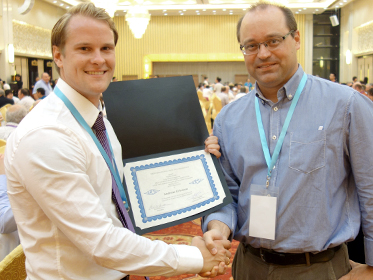 Andreas Ericsson with supervisor Daniel Sjöberg at the conference banquet. |
The paper is coauthored with Daniel Sjöberg and is entitled "A resonant circular polarization selective structure of closely spaced Morin Helices", and treats a possible realization of a reflector surface for satellite antennas. The URSI General Assembly is convened every three years for all radio scientists in the world, and about 1300 papers were presented this year.
Xilinx donates FPGA-boards
Published: 2014-08-11
EIT has received a donation from Xilinix of 28 Nexys4 FPGA-boards to a total value of around approximately US$4500. The donation will be used to modernize our laboratory exercises within the field of digital circuits.
Great success on tiny surface
Published: 2014-06-30
Thursday June 26th was a good day for, among others, Pietro Andreani at EIT, who assessed a fine performance on a VCO manufactured in STMicroelectronics 28nm FD-SOI (Fully-Depleted Silicon On Insulator) CMOS process.
– We may be among the first in Europe, perhaps even the world, measuring something in a process like this, says Pietro Andreani.
 Pietro's displaying a photo of the VCO, taken through a microscope. 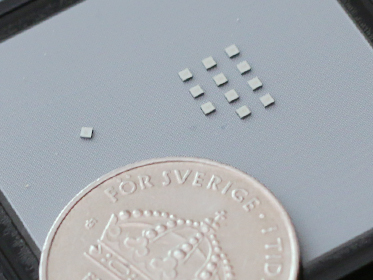 Small. VCOs and a Swedish coin (SEK 1, worth about €0,1). |
More ideal switches
Most VCOs employ standard (“bulk”) CMOS, but in FD-SOI CMOS the MOS channel is completely isolated from the substrate, which provides many additional opportunities. Thanks to FD-SOI, the MOS switches become more ideal, with significantly less parasitic capacitance. This means that the VCO tuning capacitance can be switched on and off much more efficiently.
– The result you obtain is a very large tuning bandwidth for the VCO, a bandwidth of more than an octave, with the highest oscillation frequency at 5.8 GHz and the lowest at 2.8 GHz. A factor of two (i.e., one octave) would have been excellent, and this is even exceeding it.
Will save space
The fine performance of this sub-square-millimeter VCO is interesting for modern (future) cellphones.
– With all the new bands coming up you need a VCO that can generate as many frequencies as possible. There are solutions for this already, where two VCOs or more have been used – but if you’ve got one that does it all you save a lot of space, Pietro explains.
The collaboration behind the success
It costs some 15,000 Euro per square millimeter to fabricated research ICs in STMicroelectronics 28nm FD-SOI CMOS process, and the total value for EIT (including ICs in “cheaper” processes) is estimated to above 100,000 Euro each year – but the actual cost is nil, thanks to a very good collaboration between the EIT-led research-center SoS (System Design on Silicon) and STMicroelectronics.
– We (SoS) travel to France every year to visit them. Our main contact, Andreia Cathelin, has a great part in this. She’s helped us, she’s been supporting us, and everything just works very, very well with her, Pietro says with a warm voice.
”Manage to come up with good stuff every year”
The collaboration is to some extent the continuation of the collaboration that began when STMicroelectronics and Ericsson merged, and past research successes are the basis for the continuing efforts at SoS, despite the breakup between STMicroelectronics and Ericsson. But – SoS must deliver!
– There’s pressure allright! At the same time, we’re talking about research – failure is allowed. Not too often, though, Pietro says with a smile and continues:
– We’ve had great help from people around us, such as an extremely sharp VCO designer from Ericsson, Thomas Mattsson, and others as well. We’ve got a great team here, with a strong group of skilled IC designers, and we manage to come up with good stuff every year, Pietro concludes.
Text: Johan Cedervall
Photo: Johan Cedervall
Viktor Öwall proposed as dean of LTH
Published: 2014-06-26
The LTH Nomination Committee proposes that the department head of EIT, Viktor Öwall, becomes dean of LTH from 2015 to 2017.
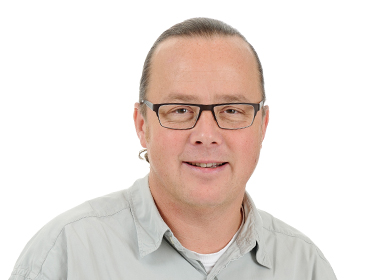 Viktor Öwall. |
The Nomination Committee's overall assessment after completion of interviews, tests and discussions, is that Viktor Öwall have the knowledge and experience necessary to utilize and further develop LTH activities. Viktor Öwall's also, according to the Nomination Committee, the candidate who best meets the requirements profile for Dean with strengths: the ability to visualize LTH national and international, experience of collaboration with industry, the ability to promote LTH's interests and cooperation within the university. Viktor Öwall also have high personal integrity, the ability to create commitment, and during his years as head of the department demonstrated a very good leadership.
Read more:
The whole assembly of the Nomination Committee (in Swedish)
Grants awarded to Electromagnetic Theory!
Published: 2014-06-25
Daniel Sjöberg has obtained two grants from VINNOVA's National Avionics Research Program (NFFP6). In collaboration with the companies Saab Electronic Defense Systems, Efield (ESI Group), Saab Aeronautics, Saab Dynamics, and Applied Composites, he will investigate a new computational method for the design of large antenna arrays, and an experimental method for characterizing scattering contributions. The project will run for three years, and together with a previously granted project in the same research program two PhD students are involved.
Best Paper to Eduardo!
Published: 2014-06-25
Eduardo Medeiros got 2 Best Paper Awards at ICC- and TAOS meetings 2014 in Sydney for his paper "How Vectoring in G.fast May Cause Neighborhood Wars". Co-authors are Thomas Magesacher, Per-Erik Eriksson, Chenguang Lu and Per Ödling. Congratulations!
 TAOS Best Paper Award presented to Eduardo |
Small antennas attracted large audience
Published: 2014-06-23
Last week, Faculty of Engineering LTH and EIT were visited by Professor Nader Behdad from the University of Wisconsin at Madison, USA. For the second consecutive year, Professor Behdad held a well-attended two-day seminar. Behdad’s research is specifically focused on periodic materials and miniaturization of antennas.
– This seminar have been highly appreciated by the participants, both from a technical perspective and from a social and networking point of view, says Gerhard Kristensson, host of the event which attracted a large proportion of the leading scientists in the Swedish aerospace industry.
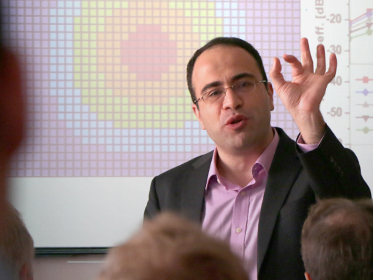 Nader Behdad was talking about small antennas. |
Hard to make smaller antennas
Making antennas smaller is a very difficult task, but very important in situations where there’s no room for bulky solutions. A good example of an application with limited space is antennas in mobile phones, where many different antennas must coexist. A modern aircraft, such as the Swedish-made aircraft JAS Gripen, is another advanced platform with lots of antennas that should fit into a small area. In those cases, you have to utilize the space available.
Continuing the tradition
Nader Behdad held a two day seminar at Lund University a year ago, in June 2013, and last week's seminar was the second consecutive for Professor Behdad who continues the tradition that began with Ben Munk (Ohio State University), described as the doyen of the area, which held a series of two-day seminars until his death a few years ago.
– The Electromagnetic Theory group at EIT has for a long time had research support from the Swedish Defence Materiel Administration (FMV) for the study of radar materials. Our success in this area has led to that we have been entrusted to organize training activities in Sweden in this research area. When Ben Munk passed away a few years ago, FMV managed to engage another key person in the field, Nader Behdad, whose research has great similarities with the Electromagnetic Theory group’s own research, says Gerhard Kristensson.
Methods for thin radar absorbers
The topic of this year's seminar was, as in previous years, the FSS (Frequency Selective structures / surfaces). FSS is about creating passive materials having specific reflection and transmission properties for different frequencies. One could call these materials "filter for radio and millimeter waves". Some frequencies one may wish to block (bandstop) or let pass (bandpass). Within the circuit electronics, the methods for designing circuit filter are well established, but when it comes to block or let through electromagnetic waves, the technology is much more complex and requires a lot of math. This is where the knowledge of the Electromagntic Theory group comes into play.
– The applications are endless! Say you want to make a surface that does not reflect certain frequencies. In optics, such a surface is black, and in radio frequency one speaks of radar absorbers used in "radio dead space", for instance in the ‘Antenna measurement chamber’. Professor Behdad has developed methods for making such material thin, which is a big challenge, and this is what the seminar’s about. Professor Behdad and his group have produced such materials and experimentally shown that they work in practice, says Gerhard.
LTH established as centre
The well-attended seminar attracted a large proportion of the leading scientists in the Swedish aerospace industry.
– Saab's various research groups are represented – Linköping, Mölndal and Järfälla. The radar materials are often produced with composite technology. Therefore, the Swedish composite industry (ACAB from Linköping) was represented. Since the research field often requires powerful mathematics, the engineering faculties at universities were represented by LTH and KTH (Stockholm). FMV of course, was present and we even had a researcher from DTU in Denmark. The Swedish Defence Research Agency (FOI) had also sent some participants, Gerhard continued.
After another successful seminar arrangement, Gerhard’s looking forward to repeat it in the future:
– We hope for a continuation of training activities for the Swedish aircraft industry at LTH. LTH has established itself as the centre for this research and I would like to see this educational activity continued. It’s an excellent example of the University's third mission, which is to bring new knowledge to our business community, says Gerhard Kristensson in conclusion.
Text: Johan Cedervall & Gerhard Kristensson
Photo: Johan Cedervall
Ardö får pengar till Rikstäckande Genealogisk Databas
Published: 2014-06-17
Internetfonden som administreras av Stiftelsen för infrastruktur (.SE) delar ut pengar till projekt som på olika sätt syftar till positiv utveckling av internet. Vid senaste utlysningen tog "Rikstäckande Genealogisk Databas – RGD, webbtjänster och släktträdsmatchning" del av dem.
Text hämtad från Internetfondens hemsida:
Projektet Rikstäckande Genealogisk Databas – RGD, webbtjänster och släktträdsmatchning ska på ett strukturerat sätt sammanställa Sveriges historiska befolkning med dess släktrelationer i en databas bestående av unika individer. I samband med detta implementeras ett antal kvalitetshöjande hjälpdatabaser och verktyg. De tas fram genom att utveckla och utvärdera en algoritm för fuzzy matchning (identifikation av gemensamma individer och familjer) av två släktträd.
Användaren ska kunna ladda upp ett släktträd i form av en GEDCOM-fil (GEDCOM är en standard för utväxlande av släktträd) och få feedback avseende kvalitet och direkta fel för namn, församlingar och datakällor. Målgruppen för dessa webbtjänster är allmänheten i form av alla släktforskare.
Webbtjänsterna kommer att vara helt öppna och fria. Kod som utvecklats i projektet kommer att vara tillgänglig med Open Source licens.
Information om projektet kommer att spridas kontinuerligt under projektets gång, bland annat genom annonsering och diskussioner på onlineforum som DIS-forum samt demonstrationer/presentationer vid DIS-möten och i andra släktforskarsammanhang. Projektet kommer också att beskrivas i tidskriftsartiklar samt via en informationsfolder som delas ut till arkivhållare, släktforskarföreningar och andra intresserade.
Projektet drivs av Anders Ardö från Institutionen för Elektro- och informationsteknik (EIT) vid Lunds universitet och Föreningen DIS.
Text: Internetfonden
Fredrik advances (in) system
Published: 2014-06-13
Fredrik Tufvesson has been promoted to professor of radio systems, twenty years after the Master of Science degree in Electrical Engineering at LTH. He's currently involved in three major projects that all seem to engage him a lot, we may see the results of them in the market within just a few years.
– I really like the mix! says Fredrik and compares the professor appointment with marriage.
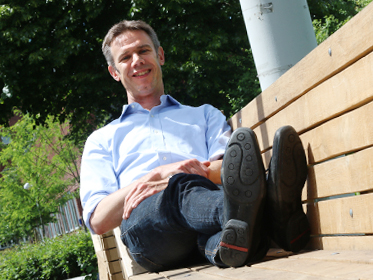 Fredrik Tufvesson Has got a relaxed approach towards the professor appointment. |
– Thogh, perhaps you shouldn't write that, says Fredrik Tufvesson with a big smile and makes one suspect that it's not 'the largest moment in life' that's intended.
– What I mean is that it's – of course – great fun but things are kind of like the day they were the day before.
Operates several large projects
He seems to live a varying and exciting life at his profession, with three comprehensive projects going on, as a dominating part of his every day:
1. Massive MIMO – a candidate to 5G.
– We've got great response to our Massive MIMO work so far. Unlike 1G-4G, 5G may be more blended and the technology best suited for the specific task will be used. 5G is believed to be avaliable in 2020.
2. Radio-based positioning.
– The advantage with radio-based positioning compared to GPS is that it works both outdoors and indoors, and may give centimeter accuracy. It opens up for new applications and services. The technology's about using radio channels in more advances ways – signals we already have in the air around us – and it creates GPS-free solutions. The challenge is to narrow the accuracy.
3. Vehicle-to-vehicle-communikation, which may be likened with a seed to a driverless traffic society.
– The vehicle-to-vehicle-communication we're working with tight now is for driver-led cars. Technology makes it possible for us to prevent accidents, like see around corners or give warnings about other things hard to discover while driving. Cars will be able to communicate with each other, new such cars with those systems will be on the markes in just three years.
Communicates with the freshmen
Parallell with the research, Fredrik is a well-used Master's thesis supervisor and he's also teaching the frehmen in communication technology.
– The preparations are not a personal favourite of mine, it demands a lot of commintment both mentally and time-wize – but it's great fun when you're there with the students, doing the actual teaching. I think the sudents are really fun! The have a good drive. You ask me to compare them with students 20 years ago – well, I'd say that in general they are not as proficient in maths – but they're better at other things, for instance in English, well, they're better to express themselves in general.
Made a promise to himself
With the underlying performances in mind, the promotion wasn't unexpected, but an academic coureer it was not always obvious for Fredrik.
– Haha, no – but I've always been interested in technology. It was, as far as I can remember, a matter of course for me to study at LTH – well, if I wasn't going to be a MD of courses – but then the plan was to do something else. That's what I planned by then.
After elementary school back home in Staffanstorp, Fredrik went to study at the technical line (high school) at Polhemsskolan in Lund.
– At high school I promisde myself to not be one out of ten thousand engineers at Ericsson builting mobile phones. I didn't want to become a small cog in some giant machine.
Curiosity is the most important thing
After spending a year at technical school in Östersund, Fredrik Tufvesson went to LTH to study Electrical Engineering 1990-1994. Subsequently, he worked on a project at Sydkraft (Eon) and IEA before he began his PhD at Applied Electronics (which two mergers and several years later became part of the EIT) under the leadership of Torleiv Maseng. After completing a doctorate in 2000, which included six months spent in Melbourne (Aus), he took employment at the Ideon company Fiberless Society. Two years later, Andreas Molisch needed some help at LTH and Fredrik thought that he could assist with some six months or maybe even a year. 12 years later, the professor title is a fact. How do you move on when you are at the top of the academic ladder?
– I think it's important to be constantly evolving, so I hope to do even as a professor. Then we'll see in which way I evolve. I think the most important thing is not to lose curiosity, emphasizes Fredrik Tufvesson, professor of radio commincation, in conclusion.
Text & photo: Johan Cedervall
2014-06-05 Best Student Paper Award to Chenxin!
Published: 2014-06-05
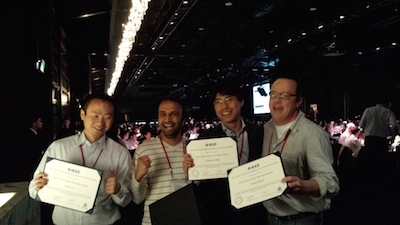 EIT congratulates the authors! Four of them at the banquet! |
2014-06-05 After successfully defending his PhD Thesis on May 27, Chenxin Zhang and co-authors received the Best Student Paper Award in competition with >600 papers at ISCAS for: C. Zhang, H. Prabhu, L. Liu, O. Edfors and V. Öwall, “Energy Efficient SQRD Processor for LTE-A using a Group-sort Update Scheme”, IEEE International Symposium on Circuits and Systems (ISCAS), 2014, Melbourne, Australia.
2014-06-02 "Curiosity in both circuit design and wireless communications brought me to Sweden"
Published: 2014-06-03
Working for Beijing Telecom Communication Cooperative after finishing college, Chenxin Zhang got in touch with Ericsson and got the idea that LTH would be a great place to be for further education. Now, some years later, EIT congratulates Dr. Zhang!
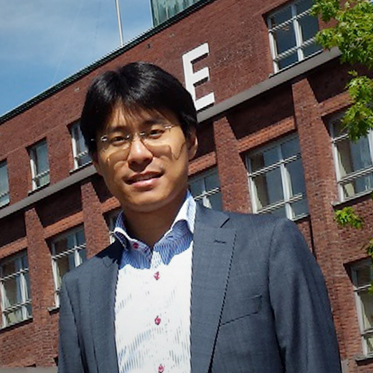 Chenxin Zhang in front of the E-building at LTH, the home of EIT. |
Aiming for providing flexible hardware platform
On May 27th, Chenxin Zhang defended his thesis "Dynamically Reconfigurable Architectures for Real-time Baseband Processing".
– Today’s hardware needs to support many different standards and to perform different tasks. For example, we want our mobile phones to support as many standards as possible such as cellular network, Bluetooth, WiFi, and GPS. This multi-standard and multi-task support is typically referred to as hardware flexibility. My research work aims at providing flexible hardware platform that can be reconfigured to suffice this purpose. In my thesis, wireless communication has been used as a main application that drives the development of reconfigurable hardware architecture.
Ericsson connecting
– After college study in China, I worked for Beijing Telecom Communication Cooperate for one year, where I got to know Ericsson for the first time. Curiosity in both circuit design and wireless communications brought me to Sweden to pursue further study at LTH, which has great research environment in both fields. I am deeply grateful for the opportunity to study here.
Love at first sight
So, what made you pursue a PhD and what's the most fascinating about your project?
– My thesis work is an interdisciplinary study in both wireless communication and digital circuit design. Both subjects are really interesting. To understand complex systems such as mobile phones has been my longing since I saw them the first time, and now I even have the possibility to actually design something for them. PhD study is a perfect way of getting close to state-of-the-art technologies, not only the present ones but also those that are being developed for future use.
The friendship – a distingueshed EIT character
Do you have any particular interesting or funny occasion during your PhD time you want to share?
– I particularly remember a trip in Los Angeles with my supervisors when I was there as a visiting scholar. Besides business, they took me around in LA, we had a walk in the Hollywood street and relaxed at the Santa Monica beach. That moment was relaxed and cheerful. I believe that the friendship among students as well as between students and supervisors is one of the distinguished characters of EIT.
Will follow research activities at LTH
What about your future plans?
– After the 1.5 and 5 years Master and PhD studies at LTH, I plan to go to industry to apply all my knowledge to real-life products. However, I will of course follow research activities at LTH, particular the ongoing projects I participated in.
2014-06-02 EIT flows well at ESSCIRC in Venice!
Published: 2014-06-01
Five EIT-articles have been accepted at this year's European Solid-State Circuits Conference (ESSCIRC). Delegates at ESSCIRC present and discuss recent advances in circuit design, highly integrated circuits and systems-on-chip technology. This is the most famous conference of circuit design in Europe and ESSCIRC-2014 will be held in Venice in September. Never before have we had so many ESSCIRC articles in a year and the record is obviously very pleasing! The accepted papers are:
Mohammed Abdulaziz, Markus Törmänen, and Henrik Sjöland, ”A 4th Order Gm-C Filter with 10MHz Bandwidth and 39dBm IIP3 in 65nm CMOS”
Oskar Andersson, Babak Mohammadi, Pascal Meinerzhagen, and Joachim Neves Rodrigues, “A 35 fJ/bit-access Sub-VT Memory Using a Dual-Bit Area-Optimized Standard-cell in 65 nm CMOS”
Carl Bryant and Henrik Sjöland, “A 2.45GHz, 50µW Wake-up Receiver Front-end with -88dBm Sensitivity and 250kbps Data Rate”
Jonas Lindstrand, Ivaylo Vasilev, and Henrik Sjöland, ”A Low Band Cellular Terminal Antenna Impedance Tuner in 130nm CMOS SOI Technology”
Luca Fanori, Thomas Mattsson, and Pietro Andreani, "A Class-D CMOS DCO with an on-chip LDO"
2014-05-21 Well targeted and good shots at AIMday!
Published: 2014-05-21
On May 15th, EIT held the first so-called AIMday-Wireless at the Bishop's House in Lund. AIM stands for Academy-Industry-Meeting and the decision to try this concept was taken just over six months ago as a result of VINNOVA demands for new approaches in terms of future industrial cooperation. EIT and LUIS (Lund University Innovation System) have pushed the project along since then with a focus on this event. Additional benefits besides established dialogues with the industry is that the department surveyed and clarified its research as well as strengthening EIT-LUIS positions for future collaborations.
In total we got 25 highly skilled representatives from 12 high-tech companies to settle in the cozy conversation rooms in the Bishop's House. Industry people presented and discussed over 20 needs related matters with nearly 40 sharp researchers from the EIT and its neighboring institutions. The nice environment , good food and relaxed setup did its part to stimulate very interesting conversations in various areas around the department's areas of expertise. The meetings were moderated by six people. The corporate list consisted of Sigma Connectivity , Axis, Sony Mobile , AudioDev , Combain , TerraNet , Huawei and others and the questions touched topics such as WLAN , LTE , positioning, mesh-networks, LED-modulation, NFC, energy-harvesting, etc.
In an initial evaluation ,we now continue with 6-7 companies for further in-depth discussions around interesting questions that were addressed during the day. There is now a fine tuning of AIMday-sights for the next shot. Feedback about the event as such, is also collected . Good things can always be improved and the bad ones must be corrected. Then we hopefully AIM again next year.
2014-04-30 Minnesord över Professor Emeritus Sven-Olof Öhrvik
Published: 2014-04-30
Sven-Olof Öhrvik, professor emeritus vid Lunds Tekniska Högskola, har avlidit 85 år gammal. Hans närmaste är hustrun Lotte och fyra döttrar.
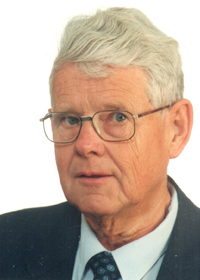 |
Sven-Olof Öhrvik kom till Lunds tekniska högskola (LTH) och institutionen för tillämpad elektronik 1986 som professor i elektronik, efter en karriär som utvecklingschef på Ericsson Radio Systems i Kista. Detta sammanföll lyckligen i tiden med att Ericsson beslutat starta mobiltelefoniutveckling i Lund, vilket bland annat resulterade i att Ideon grundades.
Under sina år på institutionen byggde visionären Sven-Olof upp en verksamhet med forskning och utbildning i den absoluta framkanten av radiovetenskap och elektronikkonstruktion. Institutionen växte kraftigt under den tiden och en omfattande såväl teoretisk som tillämpad forskning växte fram. Sina gedigna teoretiska och praktiska kunskaper förmedlade han generöst till studenter och doktorander i kurser med utomordentligt välgjord dokumentation.
Sven-Olof var en god ledare och en fin pedagog. Med en ödmjuk ledarstil ledde han institutionen fram till sin pensionering, och såg ett flertal av sina doktorander avsluta sina studier, vilka för många av dem medfört en karriär inom mobiltelefoni. Genom hans omfattande kontaktnät inom Sverige och framförallt internationellt, kom institutionen, LTH och Lunds universitet att bli välkända i den radiovetenskapliga världen. Ett exempel på detta är den verksamhet, som han inspirerade till på University of California, Berkeley, både genom forskningsprojekt och undervisning. Hans visioner tillsammans med en obändig entusiasm har haft en avgörande inverkan på mobiltelefonins utveckling i världen. Hans verksamhet på Ericsson och LTH samt hans samarbete med flera andra svenska institutioner, är viktiga orsaker till Sveriges ledande position inom mobiltelefonin globalt.
Sven-Olof var en god ledare och vän och hans bortgång är en stor förlust för oss. Mobiltelefonin och radiovetenskapen har förlorat en diskret och blygsam nestor.
För Institutionen för elektro- och informationsteknik, LTH
Viktor Öwall, Skotte Mårtensson och Lars Olsson
2014-04-24 Fascination for technology brought Isael from Mexico to Lund
Published: 2014-04-24
In his Mexican hometown Acapulco tourism is the main source of income – Isael Diaz never hesitated to travel to the other side of the globe to follow his dream to contribute to the start-of-the-art in technology. EIT congratulates Dr. Diaz!
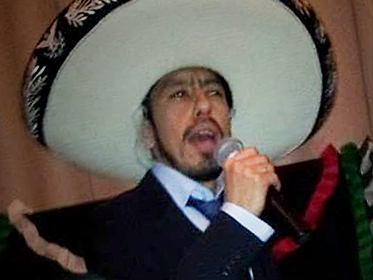 Celebrating one hat with another. Isael Diaz now has one more hat to choose from. |
Improving communication between base station and phone
On April 4th, Isael Diaz defended his thesis "Algorithm-Architecture Co-Design for Digital Front-Ends in Mobile Receivers".
– My research aimed at improving the communication between the base station and the mobile phone. Looking into aspects inside the mobile to improve one or many aspects such as connection quality, energy consumption, area, etc.
The methodology used takes a multi-disciplinary approach. In which algorithmic mathematical aspects are merged with hardware design technics, in order to arrive at better performance of the overall mobile phone.
A PhD degree – the utlimate goal
What made you want to pursue a PhD and what is the most fascinating with your subject?
– I have been always fascinated by technology. A PhD degree has been in my mind the ultimate goal towards contributing to the state-of-the-art technology. What I found most interesting in my subject is the opportunity to understand complex systems such as mobile phones.
Brought to Lund by passion for technology
Where are you from, what are your interests and how did you end up at LTH?
– Technology has always inspired me – born in Acapulco, where tourism is the main source of income, I never hesitated to move to other cities where my passion could be better understood. This passion also encouraged me to continue my studies abroad, and I found myself studying a master degree in Lund University, one of the best in Europe. I soon realized that in order to continue my quest for technological knowledge I would have to continue towards pursuing a PhD in the same institution. After some time the opportunity became true and I am deeply grateful for the opportunity.
Particular feeling to EIT
Do you have any particular interesting or funny occasion during your PhD time you want to share?
– All conference trips with colleagues have some funny and special anecdotes. I particularly remember one conference trip to Vienna that I had the pleasure to share with my PhD supervisors. It was special because it didn't feel like two professors and his student going for a business trip. It felt like three friends going out for a fun weekend together with some work involved. I believe this feeling is very particular to EIT, and it is not so often seen in an academic environment.
Heading towards the industry
What abput your future plans?
– I plan to apply all the knowledge acquired during my PhD in industry with real products and combine it with academic collaboration. In this way I could actively contribute to better and more efficient technological advances from both fronts.
2014-04-22 Professor Emeritus Sven-Olof Öhrvik has passed away
Published: 2014-04-22
During the Easter holidays we received the sad news that Professor Emeritus Sven-Olof Öhrvik has passed away. Sven-Olof was one of the really great pioneers in the area of mobile communication, nationally as well as internationally, and made enormous contributions that helped take us to the place where we are today. Even though he always had a very modest approach his importance cannot be overestimated. Mobile communication and the Swedish radio world has lost a discreet and humble eminence.
Funeral on Friday May 23rd at 11 A.M. in S:ta Birgitta church in Nockeby.
2014-04-09 Their idea opens doors and eyes
Published: 2014-04-09
Four undergraduate (third year) students who read Electromagnetic Field Theory is expecting. On April 15, they will get to know if their contest contribution, which they’ve worked on for five months, will reach the final of the IEEE Antenna Contest which in that case means that the guys can pack their bags and travel to Memphis with a chance of up to $ 1,500 in prize money - but perhaps most importantly - confirmation of their well-executed project.
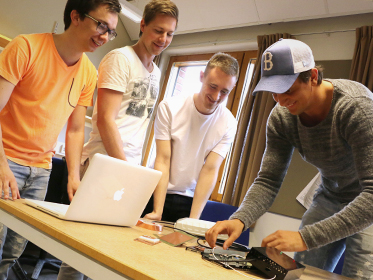 Team Electrokey. From the left: William Tidelund (-92), Filip Olsson (-90), Sebastian Andersson (-92), Edward Jovcic (-88). Photo: Johan Cedervall |
”Electrokey” simplifies everyday life
All pupils in the course Electromagnetic Field Theory got the offer last fall to come up with a project for the contest &ndash two groups submitted proposals, one of them went further and is Lund University's contribution as one of six in the world. They call it "Electrokey", an RFID system (Radio-frequency identification) with a receiving antenna and a passive "tag-antenna" which for example can be built into a mobile shell and simplify everyday life for people in today's increasingly electronic-based society.
– You may have a bus-card, car-keys, keycards and so on. Our system gathers all these in one device, and also with an improved (increased) reading distance &ndash you don’t have to touch the receiving antenna with the shell, it recognizes when you’re nearby, Edward Jovcic who’s one of the team members says.
Inspiring supervisors
After having been withdrawn – Edward, Filip, Sebastian and William got $ 1,500 to spend on the project, which in addition to technical knowledge and exploration included a requirement to work on the budget, working in a team and managing the project. They've been working on it since November 2013 and especially Professor Mats Gustafsson and PhD student Doruk Tayli was there to supervise.
 Can be mounted in a mobile shell. In that way its accessibility increases because it may be fitted to all mobile phones on the market. Photo: Johan Cedervall |
– We’ve gotten to know the people in the corridors here at EIT and understood the available enormous competence. Mats and Doruk has been an incredible support, they have truly inspired us and gotten us to maximize ourselves, the guys says coherent.
Want to invest further
It’s a little bit nervous. April 15th is the date when they will get to know if they’re in the top three and the finals in Memphis in July which in that case will be funded by the competition. The winner scoops another $1,500, the runner up $750 and second runner up $250. Their project may take further steps – prize money would give it a kick.
– We’ve thought about continuing developing the project, to invest and make a real prototype. We’ll see!
– Everyone’s really given their all in this project. We’ve sat here on Fridays and Saturdays, parallel with other studies, but… this has been great fun!
– It takes a lot of hard work to succeed. We’ve had many failures and felt ‘what are we doing, we are worthless’ but then it turns, everything falls into place and days like those nothing can bring you down from those clouds, Edward promises with a pleasant smile.
”A fantastic opportunity”
Team Electrokey will, no matter the result in the competition, look back on a successful project and newfound experiences. The fact that it’s engaged a lot of time doesn’t seem to concern them at all.
– It has been study incentive, because you get to use knowledge that you’ve collected over the years, and at the same time we feel that ’this is the way we want to work’! New challenges every day, it’s very stimulating.
– This has been a fantastic opportunity. It may be one of the funniest things one have done, Sebastian says in conclusion and the others nods assent.
SEE MORE:
Electrokey on YouTube: https://www.youtube.com/watch?v=-qKtgUDnFi8&feature=youtu.be
About the contest: http://www.2014apsursi.org/DesignContest.pdf
The team would like to thank Lars Hedenstjerna for invaluable help with manufacturing of the antennas.
Text: Johan Cedervall
Photo: Johan Cedervall
2014-04-08 Peter Nilsson appointed member of the Technical Program Comittee, ISSCC
Published: 2014-04-08
Peter Nilsson has been appointed as a Member of the Technical Program Committee of the IEEE international Solid-State Circuits Conference (ISSCC), the most prestigious conference in integrated circuit design. Peter is a member of the Energy Efficient Digital subcommittee and a member of the European Regional Committee.
Congratulations!
2014-04-01 Welcome to AIMday® Wireless
Published: 2014-04-01
LUIS (LU Innovation System) and EIT invite regional industry to the meeting platform AIMday® Wireless in Lund on Thursday 15th May at the Old Bishop’s House. Free, good food and highly interesting discussions in a relaxed environment.
Companies' need for new knowledge are matched with academic expertise from EIT and other institutions and AIMday brings new perspectives to actual problems. The event is centred on small group one-hour discussions and will hopefully render useful contacts, collaborations, and new paths in solving companies’ future needs. The format is based on submission of questions from industry, followed by signing up for interest around the questions from the researchers.
Based on this we will perform matching and establish the group discussions. We are currently approaching industry from a long list:
Ericsson, Sony, Sigma Connectivity, Axis, Anoto, Doro, Blackberry, ARM, Anritsu, Combain, Eon, IBM, Huawei and many more.
The interest is great but we will know the final attendee list first after the matching is done. Don’t miss the opportunity to take part in this highly interesting day! For more information, check out the website www.aimday.se, the flyer or get get in touch with anders.borgstrom@eit.lth.se or lennart.gisselsson@innovation.lu.se. Or stop by at Anders room for a chat.
2014-04-01 Andreani jubilees when EIT-paper is published in July
Published: 2014-04-01
Mattias Andersson, Martin Anderson, Lars Sundström, Sven Mattisson and Pietro Andreani has written "A Filtering Delta-Sigma ADC for LTE and Beyond” which will be published in the prestigeous IEEE Journal of Solid-State Circuits in July 2014.
That'll be Pietro Andreanis twentieth contribution to the journal.
Pressrelease: Världsledande testsystem för massiv MIMO byggs i Lund
Published: 2014-03-10
PRESSRELEASE 2014-03-06
Lunds Universitet har inlett ett samarbete med National Instruments för att bygga ett flexibelt och programmerbart testsystem för massiv MIMO, en av de hetaste kandidaterna både för femte generationens mobilnät och framtida WiFi-nät. I massiv MIMO samverkar tiotals till hundratals antenner för att kraftigt öka kommunikationskapaciteten, samtidigt som den utsända effekten från basstationen kan minskas rejält. Teknikens enorma potential har visat sig i teoretiska studier medan realistiska tester och utvärderingar precis tagit sin början. Med systemet kommer forskarna i Lund att kunna genomföra praktiska tester med 100 koherenta antenner på basstationen och 10 mobila enheter. Förväntningarna är höga och den kunskap som byggs upp förväntas påverka såväl forskningen som framtida standardisering av tekniken. Systemet som levereras under mars 2014 är baserat på National Instruments USRP RIO/PXI/LabView där huvuddelen av beräkningarna sköts parallellt av drygt 50 kraftfulla Kintex 7 FPGA:er från Xilinx. Samarbetet innebär även att Lunds universitet går in i National Instruments lead user program.
Forskare vid Institutionen för elektro- och informationsteknik vid Lunds universitet ses som pionjärer inom massiv MIMO, tillsammans med samarbetspartners i Sverige och utomlands.
– Vi har en lång tradition av ämnesövergripande forskning och med detta nya testsystem lyfter vi vår verksamhet till en ny nivå med ett tätt samarbete mellan olika discipliner, säger Viktor Öwall, prefekt vid Institutionen för elektro- och informationsteknik. Särskilt viktigt är deltagandet från SoS – System Design on Silicon, ett VINNOVA Industrial Excellence Center vid Lunds universitet, vilket ger oss möjlighet att ta koncept som utvecklats inom vårt strategiska forskningsområde ELLIIT och ett SSF-finansierat projekt till en helhetslösning i ett fullskaligt testsystem. Systemet som döpts till LuMaMi (Lund University massive MIMO testbed) får sitt elddop i ett nyligen startat EU-projekt, MAMMOET, där även Linköpings universitet och Ericsson deltar från svensk sida.
Kontakt: Prof. Ove Edfors (Ove.Edfors@eit.lth.se, 046 2229026), Docent Fredrik Tufvesson (Fredrik.Tufvesson@eit.lth.se, 046 2224629), Prefekt Viktor Öwall (Viktor.Owall@eit.lth.se, 046 2229469). Se även institutionens hemsida http://www.eit.lth.se
Anders coodinates for display
Published: 2014-03-06
His title is Research Coordinator but Anders Borgström often return to the parable with a broker where the ability to see both sides is essential to good business. The core of his job is to show EIT to the outside world and to coordinate research projects internally. Welcome in!
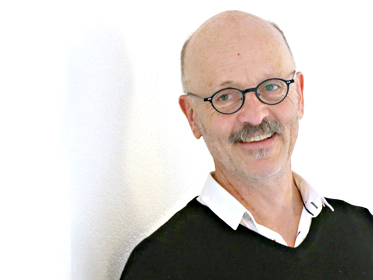 Light and fresh. Anders Borgström's display object is state of the art. Photo: Johan Cedervall |
Is not 59 years old
– No, forget what I just said, I'm only 58! My 59th birthday is not until November so it's far away, says Anders Borgström and tells me that he is married to Gunilla and has been so "as long as I can remember."
Born in Lund, raised in Trelleborg, educated in Lund and Zürich and living in both Skanör (on weekends) and Malmö (during the weekdays). His kids are grown up so one have to suppose that the family's dog both get lots of love and exercise when Anders is exercising outdoors which is the main leisure interest in addition to travelling.
– I'm going skiing next week! We've also been a whole lot in the U.S. – it'll be Chicago next time – and Australia where we have dear friends. But it's quite far there so unfortunately we can't go as often as we'd like. I love that country – the lifestyle! – warm, nice, relaxed, great wine, awesome nature.
Mobile telephony a thread
Anders has during his 34 years as an electrical engineer, mostly been working for Ericsson and Sony Ericsson with mobile telephony as the thread running through the whole career despite detour to Kockums for a couple of years ("the submarines are like big phones, they try to put as much as possible in them") and his own entrepreneurship in distribution and sales system for e-books ("e-books is a mobile-related service").
– I was involved from the beginning of mobile telephony with Ericsson and was present throughout the evolutionary journey from the Hotline to small pocket phones. From huge phones for SEK 30,000 to small ones for a dime, so to speak. I worked a lot with hardware until 2005 when I went on to work more on services, the ecosystem around the phones, Anders says.
Very intresested in technology
The private company is now dormant and Anders' focus since last year is to show EIT to the world.
– I'm very interested in technology and what's done at EIT is state of the art. It's very exciting to see things today that will benefit the public in a few years.
Deliverables are different here in comparison with the industry - we convey knowledge and research in an extremely scrutinizing and criticizing branch. But it belongs and I think it's good. One can not call himself a scientist if you have not been properly grilled, says Anders, smiling.
Creates overview for better transparency
Interest in technology and a solid background with the engineering degree and experience from some of the local industry technology giants makes Anders cut out for his mission.
– I don't understand everything that the researchers do in every detail, but understand enough to be able to take the dialogue and coordinate research on EIT internally, Anders explains.
It is a large department and the inventory has been extensive. He hands over a booklet in A4 size comprising a plurality of pages.
– I have compiled distilled descriptions of all researchers at the department. These can be used in different contexts, for example in AIMDay in May, to match our research towards future corporate needs. Another similar thing I've done, but on a group level, are the so-called microposters, where a research team is presented in a concise and clear manner – this is also a good inlet for potentially interested.
Visibility is extremely important
Visibility is one of Anders recurring motto and something he, for example, benefit from the pro-facing announcements, when dealing with Vinnova, SSF and the Swedish Research Council.
– More and more sounds more and more. We have to lift ourselves above the noise, it's essential to be seen and to show that what we have is very good! Visibility is also synonymous with the so-called third task, ie. our responsibility towards the public. We must stay ahead in terms of research and attract the right people, here too is visibility important, and we'll be working even more with increased visibility of where we'll shall be visible, says Anders who seem to thrive under the current conditions and existing challenges.
– It's a new world for me. But it's great fun!
Text: Johan Cedervall
Photo: Johan Cedervall
"Terminal Antenna Systems for 4G and Beyond"
Published: 2014-02-19
Guest Editorship for IEEE AWPL Special Cluster on "Terminal Antenna Systems for 4G and Beyond"
Buon Kiong Lau has co-edited with Marta Martínez Vázquez (IMST, Germany) the Special Cluster on "Terminal Antenna Systems for 4G and Beyond" in the IEEE Antennas and Wireless Propagation Letters (AWPL), which has just been published. The Special Cluster, consisting of a collection of 14 papers, is a joint initiative COST Action IC1004 and COST Action IC1102 (VISTA) to showcase latest research activities in the area. IEEE AWPL is the journal with the second fastest turnaround time among all IEEE
publications.
Datum för inträffande:
February 2014
Challenges: Ageing, No Failure Found
Published: 2014-02-17
You may have experienced one of those, or perhaps both. And perhaps also in your electronic devices. EIT researchers will work on understanding fault behavior, build suitable embedded instruments and network to detect, diagnose and handle faults during operation.
 Erik Larsson. Photo: Johan Cedervall 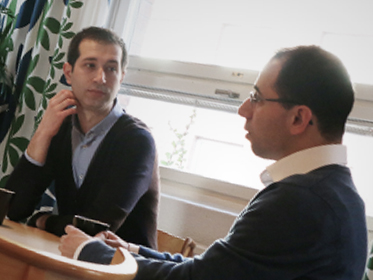 Dimitar Nikolov and Farrokh Ghani Zadegan. Photo: Johan Cedervall |
The EU FP7 project BASTION - Board and SoC Test Instrumentation for Ageing and No Failure Found – focuses on problems related to ageing and No Failure Found (NFF).
Ageing is when a device functions correct initially (when purchased) but after some time in operation the device becomes defective. The International Technology Roadmap for Semiconductors (ITRS), 2012, lists ageing as one of the most difficult challenges of process integration that affects reliability.
– Electronics is used in very many different types of systems. For electronics used in cars, trucks, trains, airplanes and telecommunication systems it is important with correct operation through the whole lifetime of the systems, says Erik Larsson.
No Failure Found (NFF) is when a device seems defective in operation but when taken to a repair-shop no problem can be found. According to an Accenture Report, 2008, around 70% of all product returns were characterized as NFF, and cost-wise, NFF amounted to about 25 USD per year per capita.
– If one translates this to Sweden, the cost per year is about 1,7 billion SEK, Erik says.
The BASTION project will work on understanding fault behavior, build suitable embedded instruments and network to detect, diagnose and handle faults during operation.
From EIT will, besides Erik Larsson, Dimitar Nikolov and Farrokh Ghani Zadegan work in the project.
BASTION is coordinated by Testonica (Estonia). Besides Testonica, the industrial partners are Aster Technologies (France) and Infineon Technologies AG (Germany). In addition to EIT, the academic partners are Politecnico di Torino (Italy), Tallinn University of Technology (Estonia), University of Twente (Netherlands), and Hochschule Hamm-Lippstadt (Germany).
Text: Erik Larsson & Johan Cedervall
Photo: Johan Cedervall
Generous donation
Published: 2014-02-13
Researchers at EIT have received a generous donation from Xilinx in the form of IP blocks to be used in research projects on Massive MIMO to a total value of US$31.850.
Large grants to EIT
Published: 2014-02-10
Mats Gustafsson and Lars-Erik Wernersson have been granted 17 and 32 million SEK over five years for resarch in applied mathematics and electronics.
Mats Gustafsson’s project is granted money within applied mathematics and is called ”Complex Analysis and Convex Optimization for Electromagnethic Design”.
http://www.stratresearch.se/sv/ssf/Nyheter/2014/120-miljoner-till-tillampad-matematik/
Lars-Erik Wernersson’s granted 32 million SEK within electronics, the project is called ”III-V Nanowires for Post-CMOS Applications”. http://www.stratresearch.se/sv/ssf/Nyheter/2014/250-miljoner-till-elektronikforskning/
Sydsvenskan: "A venue for researchers"
Published: 2014-02-09
Professor Björn Landfeldt about Mapci (The Mobile and Pervasive Computing Institute at Lund University) in an Sydsvenskan article (in Swedish):
http://www.sydsvenskan.se/ekonomi/en-motesplats-for-forskare/
2014-02-07 För nit och redlighet
Published: 2014-02-07
Tre personer vid EIT uppmärksammades under gårdagskvällen för "nit och redlighet" under högtidliga omständigheter i Universitetshusets aula och med en efterföljande middag i AF-borgen. Rektor Per Eriksson stod för utdelande av hyllningar av den långa gemensamma gärningen och gåvor till de långvariga medarbaterna vid Lunds universitet.
Från Wikipedia:
Guldmedaljen För nit och redlighet i rikets tjänst (förkortad GMnor) är Sveriges flitigast utdelade belöningsmedalj. Den tilldelas jämlikt SFS 1974:225 (lagen.nu) den som oförvitligt skött en statlig tjänst och därvid "visat nit och redlighet såsom anställd hos staten under minst 30 år". Medaljen reorganiserades på 1830-talet av kung Karl XIV Johan, efter ett initiativ av kung Gustav IV Adolf 1803. Nya stadgar antogs 1947.
Medaljen präglas i 23 karats guld, väger 11 gram och har en diameter av 27,5 mm; enligt den av Carl Reinhold Berch upprättade numismatiska skalan sägs medaljen vara "av sjätte storleken". Den är krönt av en kunglig krona och bär den regerande monarkens bild. Medaljen bärs på vänstra delen av bröstet i ett 28 mm brett, blått band med gula kanter. Bandet är för herrar rakt, för damer en rosett. GMnor är i dess nuvarande utförande på åtsidan försedd med konung Carl XVI Gustafs porträtt i profil utfört av Ernst Nordin. Frånsidan har texten "För nit och redlighet i rikets tjänst" jämte mottagarens namn och en eklövskrans.
Den som ej önskar mottaga sin belöning i form av guldmedalj kan, då man blivit aktuell att förlänas GMnor, till statsverket anmäla, att man i stället önskar mottaga ettdera av följande:
1.En för ändamålet av konstnären Gunnar Cyrén vid Kosta glasbruk speciellt utformad skål i helkristall (190 mm hög, och ca 205–150 mm i omfång) med gravyrer utförda av Lisa Bauer, på cuppan i form av linnéablomster, på foten Lilla riksvapnet.
2.En helkristallskål (135 mm hög, 235 mm i diameter) formgiven av Gunnar Cyrén
3.Ett armbandsur (guldklocka) i herr- eller dammodell.
4.Ett till personens verksamhet på särskilt sätt anknutet föremål enligt beslut av den aktuella myndigheten.
Rektor Per Eriksson välkomsttalade och lämnade därefter över till professor Jurek Pyrko som föreläste om energieffektivisering innan det var dags för Per Eriksson att dela ut gåvorna till de medarbetare som förvaltningschef Susanne Kristensson läste upp namnen på. Slutligen fick församlingen lyssna till ett flöjtstycke framfört av Ebba Wallén innan middagen i AF-borgen tog vid.
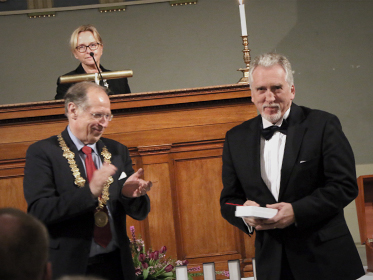
Bertil Larsson.
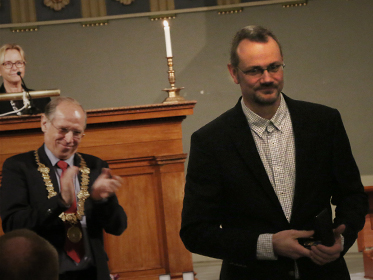
Per-Henrik Ramussen.
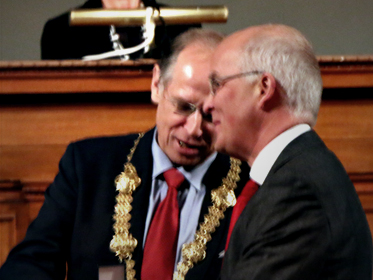
Leif Sörnmo.
Foto: Johan Cedervall
2014-01-29 New EU project on Massive MIMO
Published: 2014-01-29
In the last call for the EU FP7 program, EIT was part of three successful project proposals that will be presented here in the coming weeks when they have had their respective kick-off meetings. First one out is MAMMOET - Massive MIMO for Efficient Transmission which had its kick-off in Villach, Austria, at the site of Infineon last week.
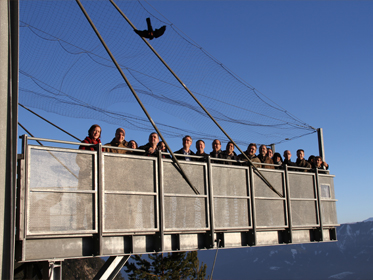 |
This really exciting project focuses on one of the most vibrant areas of wireless communications today - massive MIMO. EIT will contribute in several areas, stretching from implementation and optimization of digital signal processing to characterization of the propagation channels. EIT is one of the pioneers in the area together with our ELLIIT partner Linköping University, and in the project we expect to increase both power and spectral efficiency of wireless communications by one of more orders of magnitude, as compared to the systems used today.
Several researchers from EIT are involved led by Ove Edfors with the help of Fredrik Tufvesson and Viktor Öwall.
In addition to EIT the project partners are: Linköping University and Ericsson from Sweden, IMEC and KU Leuven from Belgium, Telefonica from Spain and Infineon and Technikon from Austria.
Winner of CST University Publication Award 2013
Published: 2014-01-21
Two staff members at EIT (Hui Li and Buon Kiong Lau) have co-authored a paper that has been chosen from among 140 entries as one of the four winners of the CST University Publication Award 2013:
Hui Li, Buon Kiong Lau, Zhinong Ying, and Sailing He, "Decoupling of Multiple Antennas in Terminals With Chassis Excitation Using Polarization Diversity, Angle Diversity and Current Control" IEEE Transactions on Antennas and Propagation, vol. 60, no. 12, pp. 5947-5957, December 2012
The paper introduces a new method to design two antennas on a mobile handset that can be placed very close to each other without interfering with each other. This allows the antenna system to provide high data rates in an efficient manner. The promising design approach has also been filed as a patent application through Sony Mobile Communications AB.
All submissions were evaluated on a number of criteria, including originality of the application or the theory, clarity of presentation, as well as the skillful usage of CST software features. The winners of the University Publication Award are granted a one-year extension of an existing CST license.
Read more:
https://www.cst.com/Content/News/2013_CST_Uni_award_web.pdf
http://www.microwavejournal.com/articles/21255-cst-university-publication-award-2013-winners-announced
2014-01-15 In memoriam - E-sektionens förste professor Lars Löfgren (1925-2013)
Published: 2014-01-15
Ensamseglaren professor Lars Löfgren avled hastigt av hjärtinfarkt den 24 juli 2013 i sin älskade segelbåt Scylla då han besökte hamnen i Ystad på väg till Stockholm. Lars växte upp i Stockholm och var son till den legendariske professorn i radioteknik vid KTH, Erik Löfgren, som bland hifi-entusiaster är känd för den ”Löfgrenska böjen” (krökningen av en tonarm).
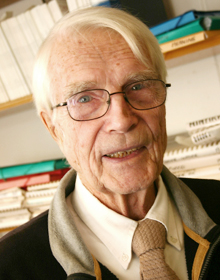 Lars Löfgren (1925-2013). Foto: Mats Nygren |
Lars började på 40-talet studera vid avdelningen för teknisk fysik vid KTH och avlade civilingenjörsexamen 1949. Han blev teknologie licentiat i matematik och tillämpad matematik 1954. Parallellt med sina studier och forskning var Lars anställd vid Försvarets forskningsanstalt (FOA) fr o m 1947. Bland Lars tidiga publikationer märks ”Apparat lösande algebraiska ekvationer” 1948 och ”A transistor multiplier”. Den senare publicerades i Quarterly Progress Report, Oct. 15, 1952 (MIT RLE), vilket är endast fyra år efter uppfinningen av transistorn. Han utvecklade också en analog multiplikator baserad på Hall-effekten. Den utnyttjades i flygstridsledningsapparatur. Lars arbete med elektronikkonstruktioner under tidiga 50-talet utgjorde en god grund då han långt senare egenhändigt tillverkade en autopilot till Scylla.
Mot slutet av 50-talet tog Lars intresse för logik och matematisk logik fart och han studerade ingående fundamentala frågeställningar rörande kontakt- och grindnät. Lars gav ett konstruktivt kriterium för när en binär matris kan vara incidensmatris för en lineär graf. Detta resultat har skattats högt. Ett annat av hans djupare resultat från den tiden är ”Solution to the realizability problem for irredundant Boolean branch-networks”, Journal Franklin Institute, 1959. I början av 60-talet tillbringade Lars två år vid University of Illinois, Urbana-Champaign. Han hade vid den tiden redan intresserat sig för självreparation och självreproduktion relaterat till automatteori. Intresset för självreproduktion hade under 50-talet blommat upp med bidrag från internationellt ledande forskare som von Neumann, Moore och Shannon. Till det stora intresset för området bidrog den vid tiden förmodade svårigheten att tillverka tillförlitliga komponenter. Utvecklingen inom mikroelektroniksområdet har dock visat att problemets svårighetsgrad var gravt överskattad. Lars egna bidrag till detta område kompletterade hans arbeten inom switchnät och utgjorde stommen i hans doktorsavhandling ”A study of deterministic and stochastic nets with emphasis on switching nets and self-repairing automata” som han försvarade vid KTH 1962.
I ”Kinematic and Tesselation Models of Self Repair” från 1962 studerade Lars problemet med livslängden hos autonoma komplexa system byggda från otillförlitliga komponenter. Resultatet var tankeväckande med självklara konsekvenser för teoretisk biologi. Ett system kan ha en obegränsad livslängd under två förutsättningar. Den första är intuitivt naturlig – systemet måste kunna reparera sig själv. Den andra är mer överraskande – systemet måste växa! Det finns forskare som drog slutsatsen att nödvändigheten att växa implicerar att mänskligheten, betraktad som ett autonomt komplext system, förr eller senare måste expandera utanför jorden för att överleva. Intressant och oväntad är sista meningen i uppsatsen ”why is our universe expanding?”. Detta är någonting typiskt för Lars vetenskapliga rapporter, när man minst anar det kommer det en djup fråga eller en idé som öppnar dörren för en intressant reflektion.
1961 grundades LTH. Först bildades sektionen för teknisk fysik. Året efter antogs de första teknologerna till elektroteknikutbildningen. I årskurs 2 läste de två obligatoriska kurser i ämnet elautomatik, vilket vid den tiden var unikt för Lund. Lars utsågs 1963 till professor i elautomatik och blev därmed, med en veckas marginal, E-sektionens förste professor. Elautomatik var enligt ämnesbeskrivningen avsett att ge en bild av de elektrotekniska metoderna för informationsbehandling av styr- och datasystem.
Kurserna i elautomatik kompletterades senare med fortsättningskurserna i automatteori baserade på matematisk logik, beräknebarhets- och komplexitetsteori. Som lärare var Lars mycket krävande. Hans föreläsningar var innehållsrika och alltid på en hög abstraktionsnivå, tyvärr överskattade han ofta studenternas förmåga att ta till sig budskapet.
Högskolor i Sverige har tre huvuduppgifter: forskning, utbildning och en så kallad tredje uppgift – att dela med sig av kunskap via olika slags utåtriktade och uppsökande verksamheter. Lars har i den tredje uppgiftens anda skrivit flera populära artiklar där han presenterar sin forskning, t. ex. ”Självreparerande automata” i Teknisk tidskrift, 1962, som på ett överraskande lättläst och informativt sätt sammanfattar hans doktorsarbete.
Åren 1966-1968 besökte Lars för andra gången University of Illinois. Han deltog aktivt i arbetet i Biological Computer Laboratory (BCL) som leddes av hans livslånge vän och mentor, professor Heinz von Foerster. Man kan tryggt säga att BCL vid den tiden var cybernetikens Mekka, en mötesplats för de flesta stora namn i denna vetenskap. Lars publicerade 12 vetenskapliga arbeten under sin tid vid BCL.
Mot slutet av 60-talet inriktade Lars sin forskning mot generella informationsbegrepp medan han som emeritus alltmer kom att intressera sig för fenomenet holistiska språk med komplementaritet mellan beskrivning och interpretering och logisk självreferens som några av nyckelbegreppen. Under de senare åren har han publicerat ett antal arbeten i teoretisk fysik och kvantmekanik i vilka han studerade fysikens fundamentala frågor utifrån ett lingvistiskt perspektiv.
Cybernetiken genomgick en dramatisk utveckling under de senaste 60 åren, från ingenjörscybernetik i Wieners och von Neumanns anda, via biologisk cybernetik till social cybernetik och kunskapsteori. Lars vetenskapliga intressen och hans forskargärning följde nästan parallellt med denna utveckling. År 2008 tilldelade The American Society for Cybernetics (ASC) honom ett välrenommerat pris ”The Norbert Wiener Gold Medal for Cybernetics” med motiveringen “for outstanding and profound lifelong contributions to cybernetics, especially in foundations”.
Det elektroniska arkivet LUP vid LTH innehåller en stor och representativ samling av Lars vetenskapliga arbeten från åren 1961-2008.
Lars var en mycket flitig ensamvarg. Han besökte ofta sitt arbetsrum på institutionen för att forska fram till sista långseglingen.
Rolf Johannesson, professor emeritus i informationsteori
Ivan Kruzela, universitetslektor emeritus i kommunikationsteknik
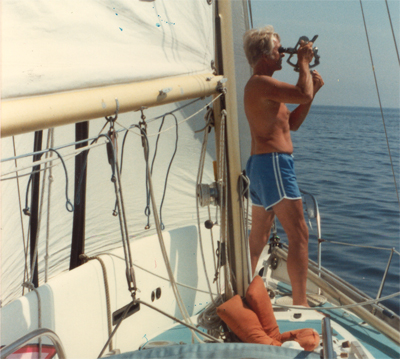
Lars Löfgren tar ut positionen på sin älskade segelbåt Scylla. Foto: Privat
Foto: Porträttbild av Mats Nygren, bild på segelbåt Privat.
